Performance boosted by 20%, power consumption reduced by 40%! AMD Ryzen ThreadRipper 9980X/9970X First Review: Leading the HEDT Platform
![]() 07/31 2025
07/31 2025
![]() 474
474
I. Preface: A Test with Four Processors Totaling 130,000 Yuan
Back in 2017, AMD processors were struggling in various fields, with a market share that was barely visible!
Who could have imagined that just eight years later, AMD would be leading the market in terms of product performance and market share across servers, workstations, desktops, and laptops, leaving Intel struggling to keep up.
Especially in the field of servers and data center CPUs, which represent the cutting-edge technology and highest performance, AMD EPYC has already left its competitors far behind.
The Ryzen ThreadRipper processors, derived from EPYC, have established an unshakeable position and image. Since its inception, it has been affectionately known as the "Ripper", completely tearing apart competing products and forcing the once-dominant Core X series out of the market!
Even so, the Ryzen ThreadRipper series has never "squeezed toothpaste" like its competitors, with each generation bringing huge leaps forward, more cores, and stronger performance.
Today, AMD brings us the Ryzen ThreadRipper 9000 series processors based on the new Zen 5 architecture, which will be the best product ever for the HEDT enthusiast desktop platform.
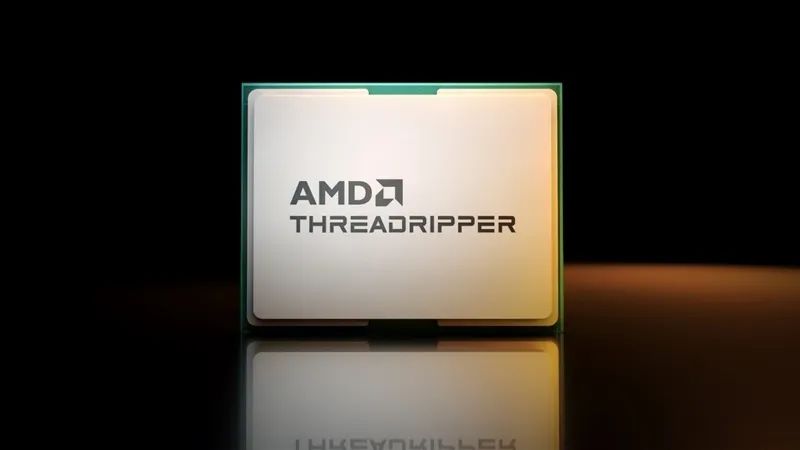
Let's first take a look at the technological innovations of the Zen 5 architecture!
1. More Arithmetic Logic Units (ALU)
With increasingly mature design capabilities, AMD's engineers have significantly increased the pipeline width of the Zen 5 core. The ROB reorder buffer has been increased from 320 entries to 448 entries, an increase of 40%.
The wider pipeline allows the Zen 5 core to accommodate more Arithmetic Logic Units (ALU) and Address Generation Units (AGU).
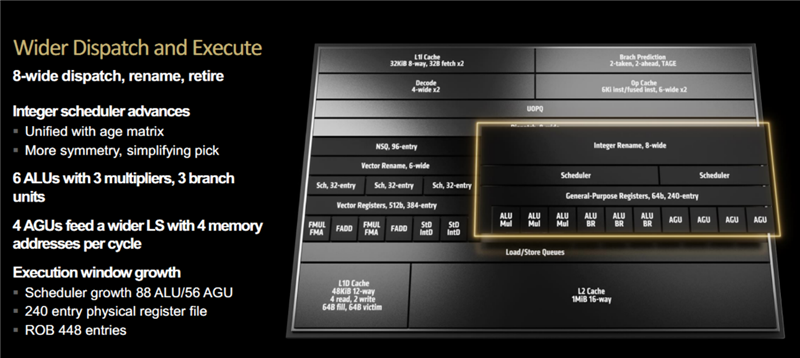
Each integer unit in the Zen 4 architecture contains 4 ALUs and 3 AGUs, while Zen 5 increases these to 6 and 4, respectively.
In particular, the number of crucial ALU units has increased by 50% compared to the previous generation, which means that the Zen 5 core can process more instructions in the same cycle.
2. Increased Scheduler Throughput
Zen 4 has 3x24 integrated ALU/AGU Schedulers and a separate 1x24 ALU Scheduler, totaling 96. Zen 5, on the other hand, features 88 ALU Schedulers and 56 AGU Schedulers, theoretically increasing computational throughput by 50% and significantly improving integer operation efficiency.
3. Faster L1/L2 Cache
Zen 5 primarily improves the L1 Data Cache, increasing it from 8-way 32KB in Zen 4 to 12-way 48KB.
At the same time, the maximum bandwidth to the L1 cache and floating-point units has doubled compared to the previous generation, and data prefetching has been improved.
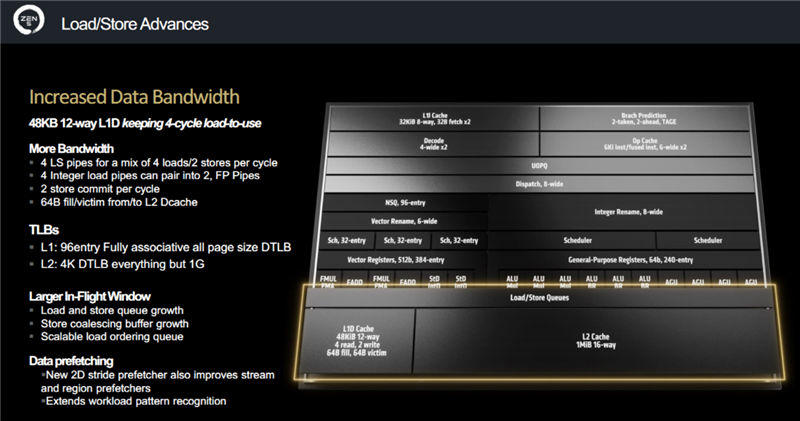
The capacity of the L2 cache remains unchanged at 1MB per core, but the link channels have doubled from 8-way to 16-way. Simply put, the L2 bandwidth has doubled.
Faster L1/L2 cache allows the Zen 5 core to maintain more stable peak performance, especially suitable for the workstation market that requires high loads for extended periods.
In addition to integer performance, the floating-point performance of Zen 5 processors has also been enhanced, with a full-width AVX 512 instruction set.
While the Zen 4 architecture also supports AVX 512 floating-point operations, it does so through the combined operation of two 256-bit FPUs, whereas Zen 5 has a full 512-bit FPU and a pipeline that matches its width.
For programs that support the AVX 512 instruction set, the Zen 5 architecture can bring up to a 100% performance boost!
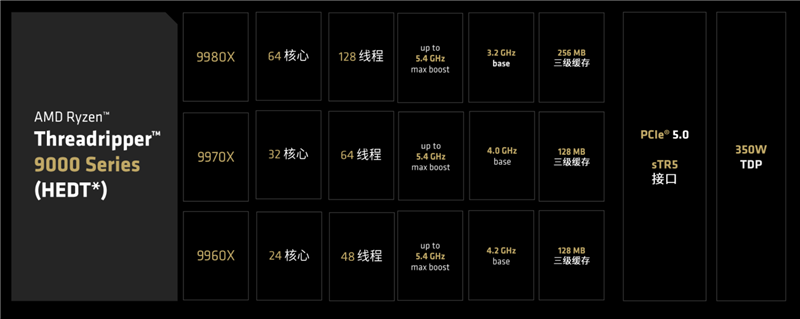
The ThreadRipper 9000 series processors come in three models: ThreadRipper 9980X, ThreadRipper 9970X, and ThreadRipper 9960X, with 64, 32, and 24 cores, respectively.
The ThreadRipper 9980X features 64 cores and 128 threads, a 256MB L3 cache, support for quad-channel DDR5 5200MHz memory, a base frequency of 3.2GHz, a maximum boost frequency of 5.4GHz, 48 PCIe 5.0 lanes, 32 PCIe 4.0 lanes, and a TDP of 350W.
The ThreadRipper 9970X has 32 cores and 64 threads, a 128MB L3 cache, support for quad-channel DDR5 5200MHz memory, a base frequency of 4.0GHz, a maximum boost frequency of 5.4GHz, and a TDP of 350W.
The ThreadRipper 9960X has 24 cores and 48 threads, a 128MB L3 cache, support for quad-channel DDR5 5200MHz memory, a base frequency of 4.2GHz, a maximum boost frequency of 5.4GHz, and a TDP of 350W.
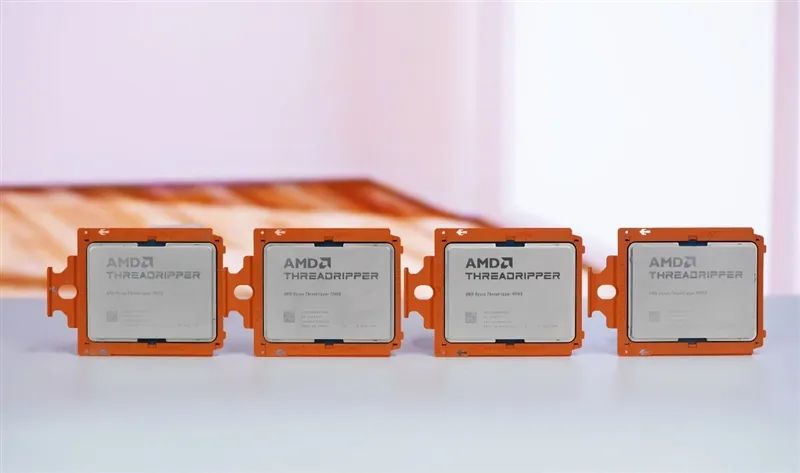
This time, we received the ThreadRipper 9980X and ThreadRipper 9970X processors, and we will also include the previous-generation ThreadRipper 7980X and ThreadRipper 7970X in our tests.
The total value of the four processors involved in the test exceeds 130,000 yuan!
II. ThreadRipper 9980X/9970X Image Gallery
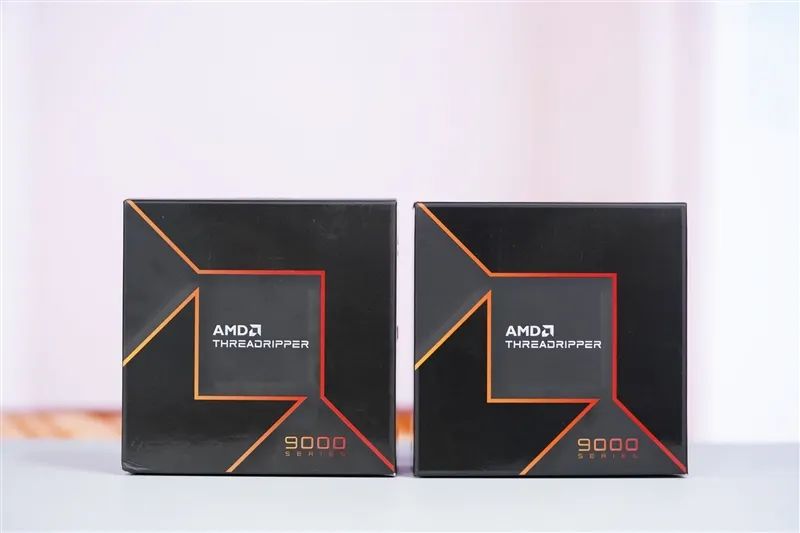
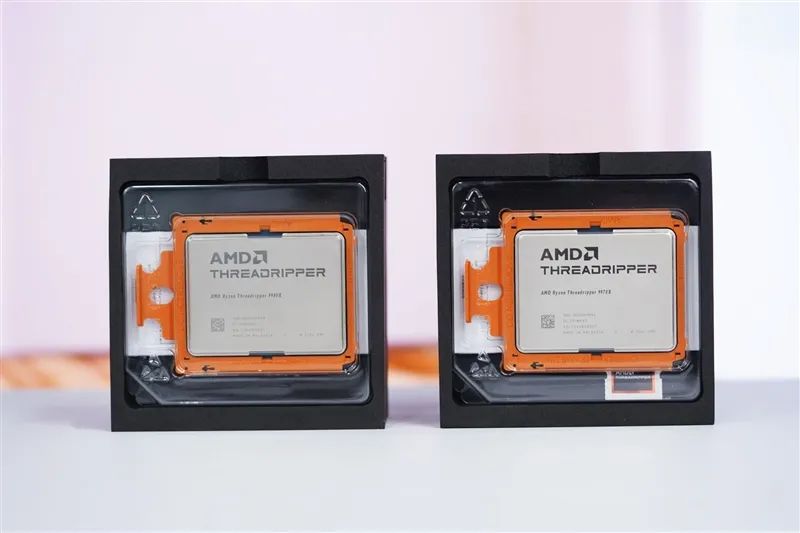
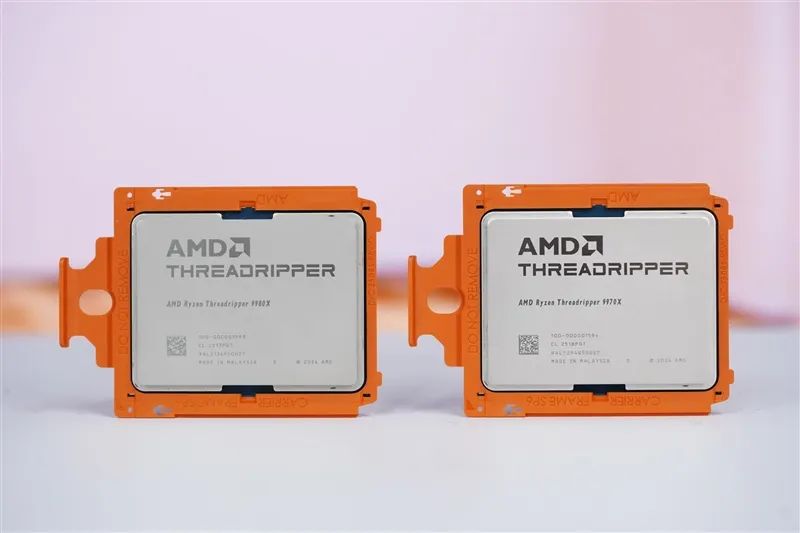
ThreadRipper 9980X and ThreadRipper 9970X.
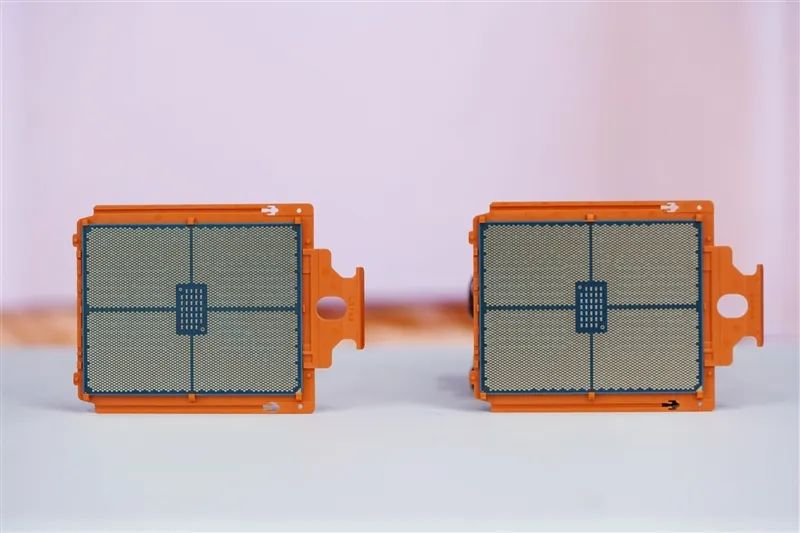
Back side.
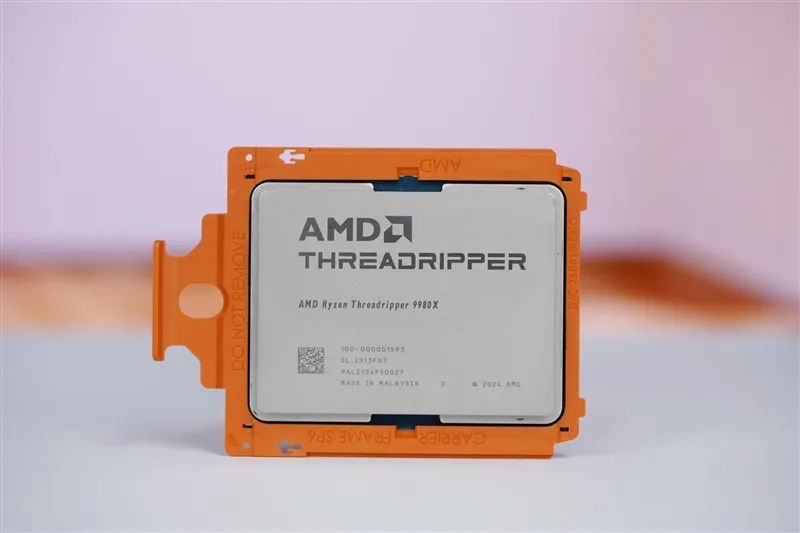
ThreadRipper 9980X.
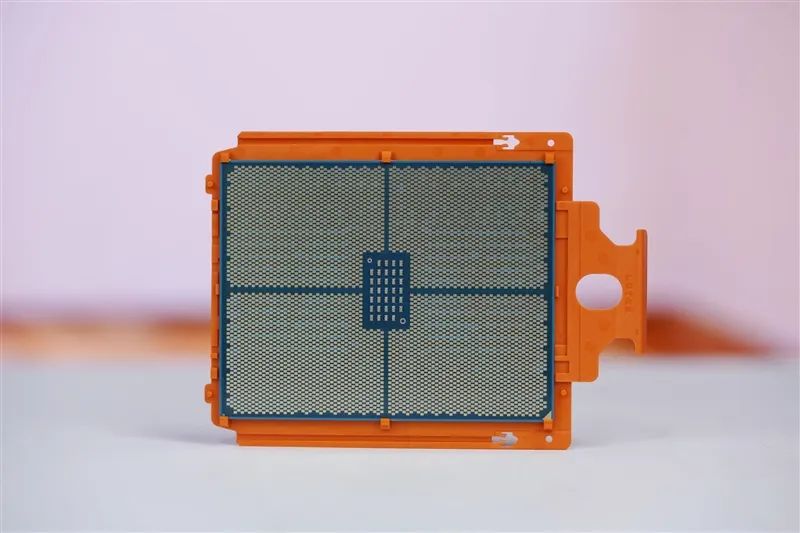
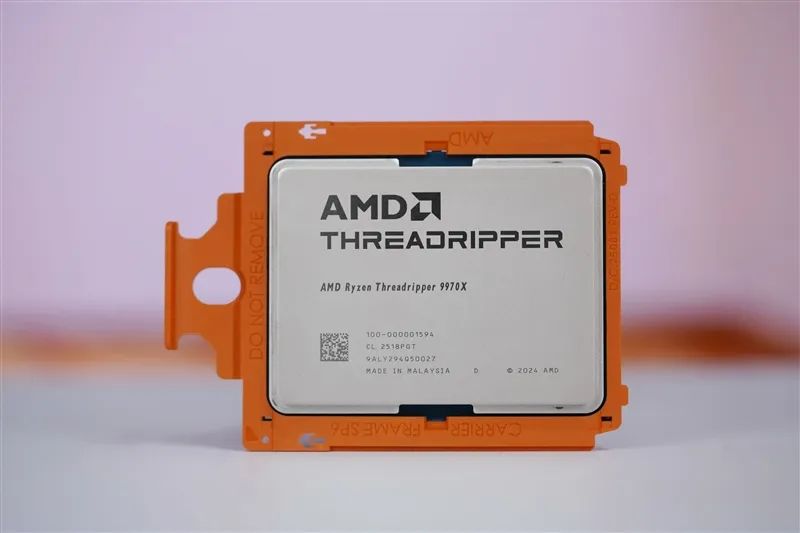
ThreadRipper 9970X
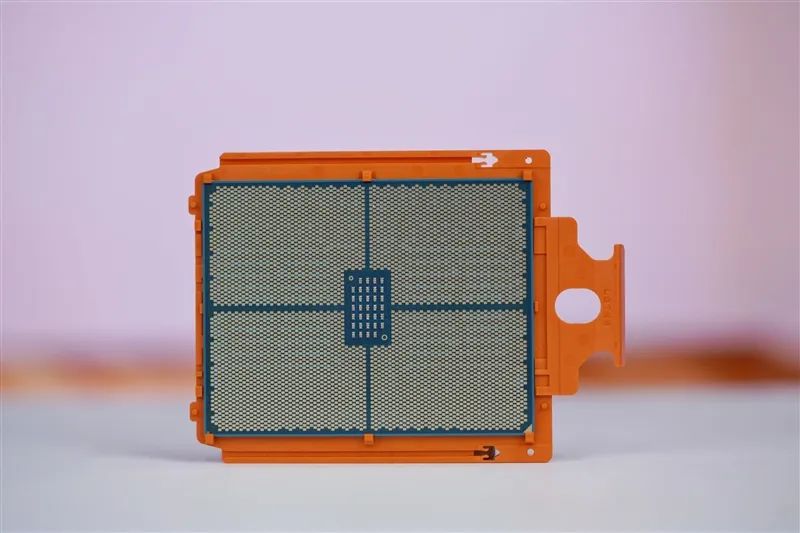
The back side is the same as the ThreadRipper 9980X.
III. Test Platform: SilverStone Full-Coverage Water Cooling + Segotep 1300W Platinum Power Supply
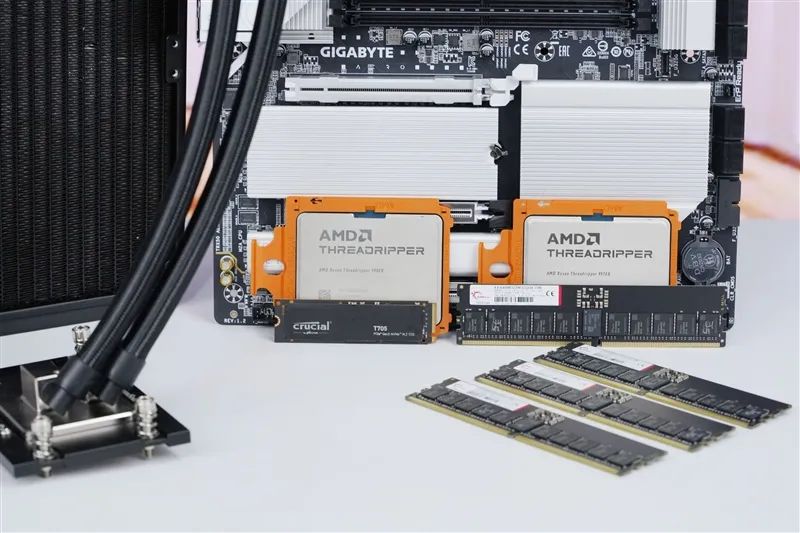
Test kit, including ThreadRipper 9980X, ThreadRipper 9970X, ASUS PRO WS TRX50-SAGE WIFI-A motherboard, Crucial T705 1TB PCIe 5.0 SSD, SilverStone XE360-TR5 water cooling radiator, G.Skill DDR5 RDIMM 6400MHz 32GBx4 memory.
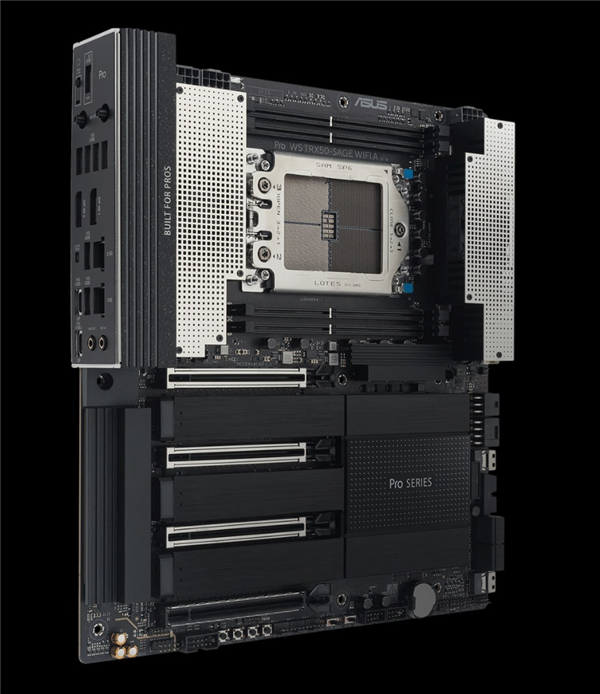
ASUS PRO WS TRX50-SAGE WIFI-A motherboard, with SP6 socket and 36-phase power supply.

G.Skill DDR5 RDIMM 6400MHz 32GB memory, with a total of 4 sticks, totaling 128GB.
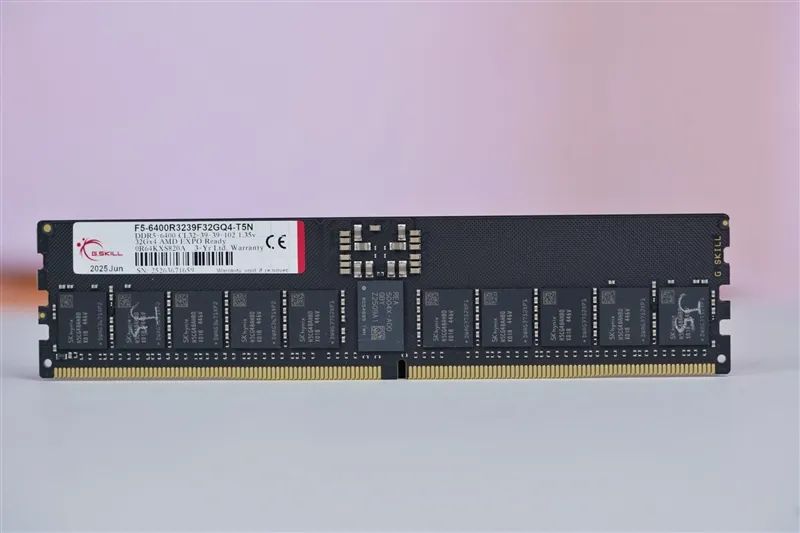
Memory frequency is 6400MHz, with timings of CL32-39-39-102 and a voltage of 1.35V, in bare stick form without a heat spreader.
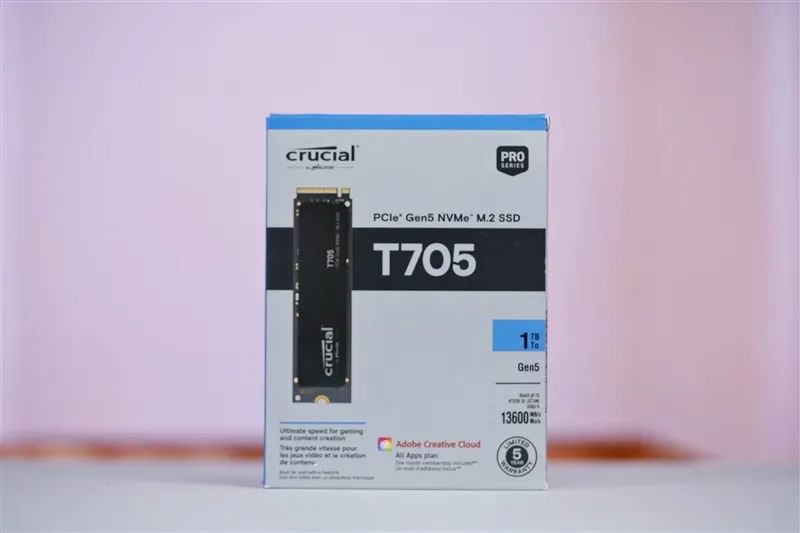
Crucial T705 1TB PCIe 5.0 SSD, with a maximum sequential read/write speed of 13600MB/s.
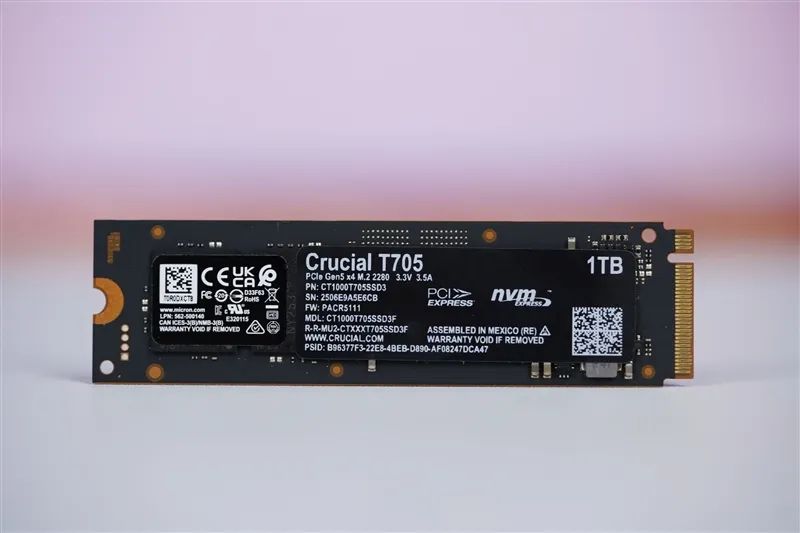
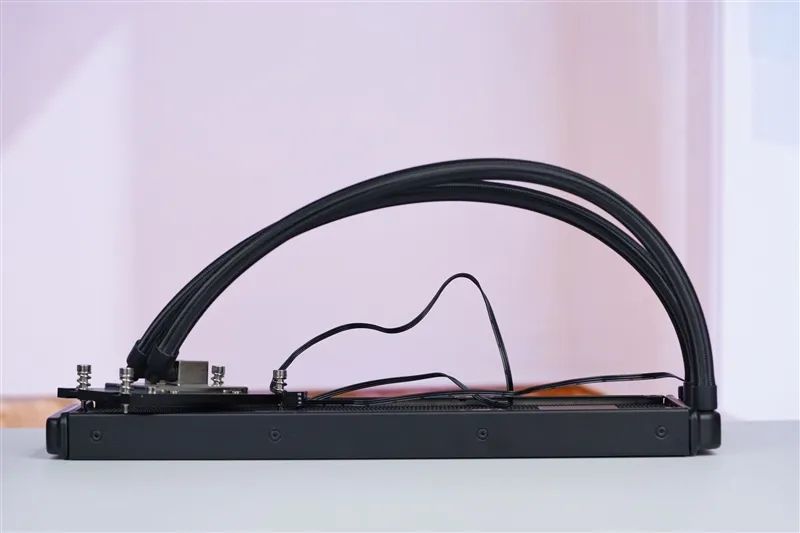
SilverStone XE360-TR5 water cooling radiator.
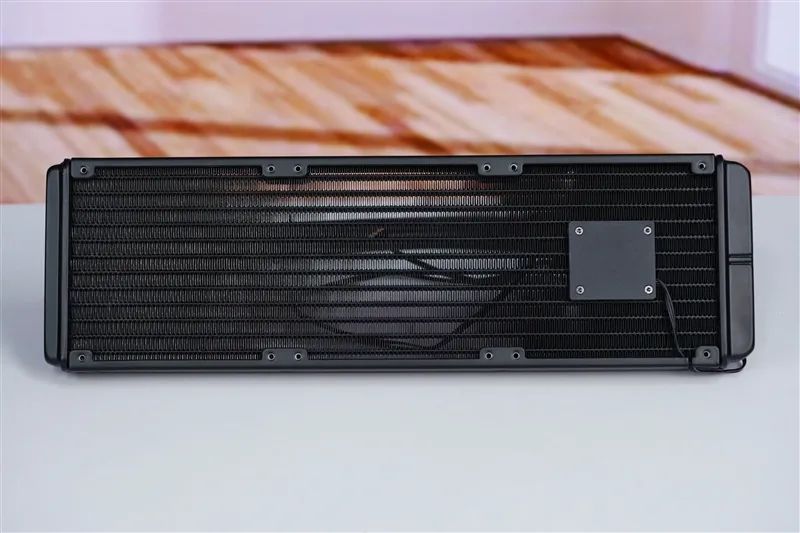
The water pump and radiator are integrated.
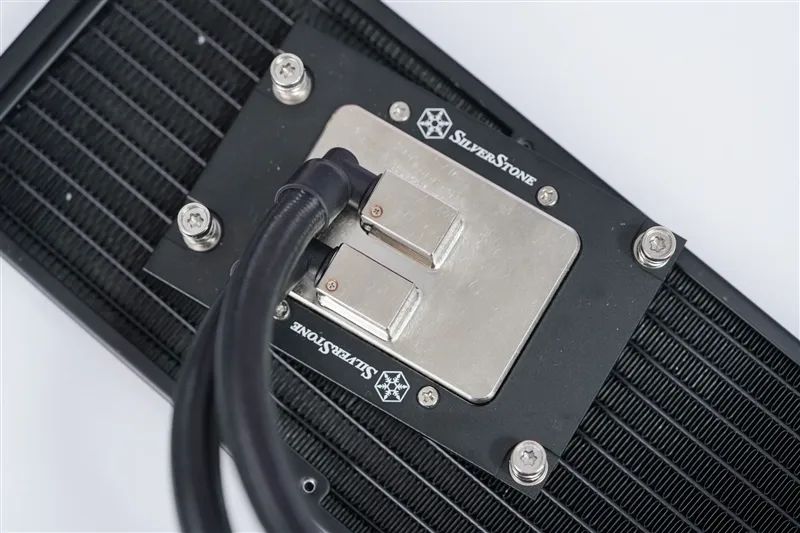
After removing the water pump, the cold plate can be made very flat.
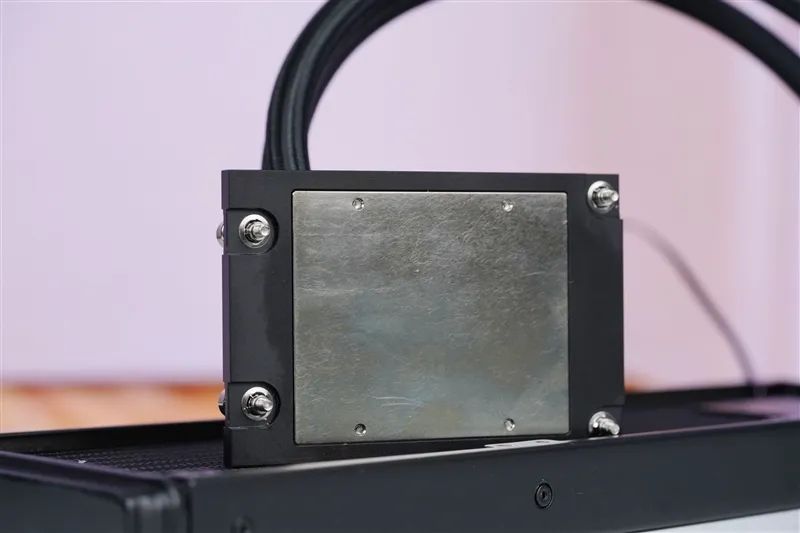
The water block specifically designed for ThreadRipper can fully cover the entire processor, and there are only a handful of water blocks that can achieve this.
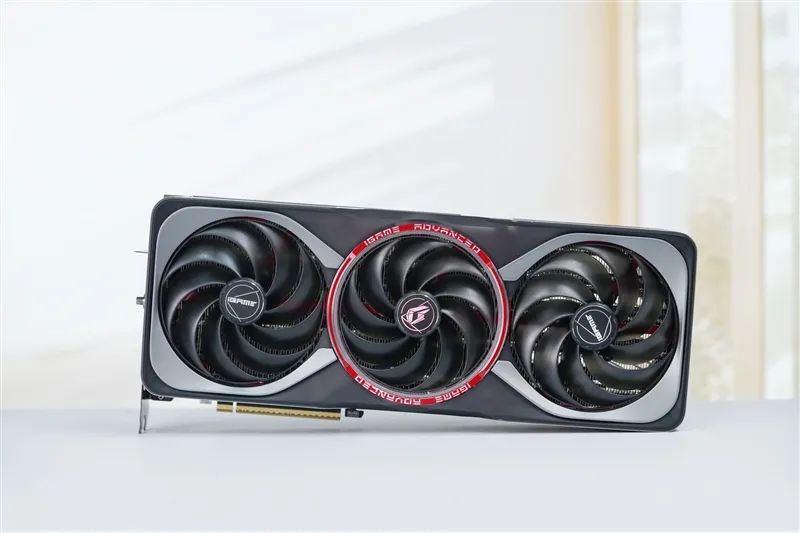
The graphics card is the Colorful iGame RTX 5090D Advanced with 32GB of memory.
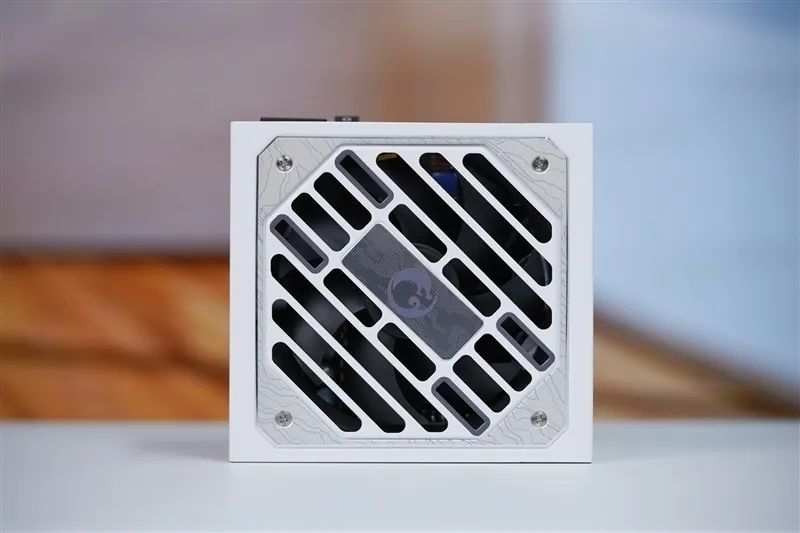
The Segotep Kunlun Jiuzhong KE-1300P Platinum digital power supply can intelligently follow voltage/power and will not experience voltage drops under extremely high loads, as ordinary power supplies might.
IV. Stress Test
1. BIOS Default Settings Stress Test
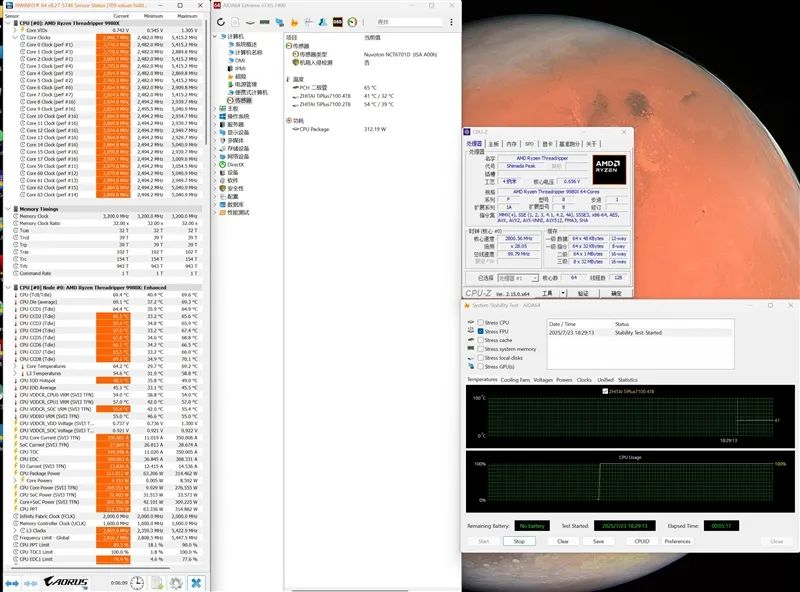
This is the stress test performance of the ThreadRipper 9980X under default settings. Strangely, the TDP is 350W, but the stress test power consumption is only 312W, with a core temperature below 70°C. During the stress test, the all-core frequency is between 2.8~2.95GHz.
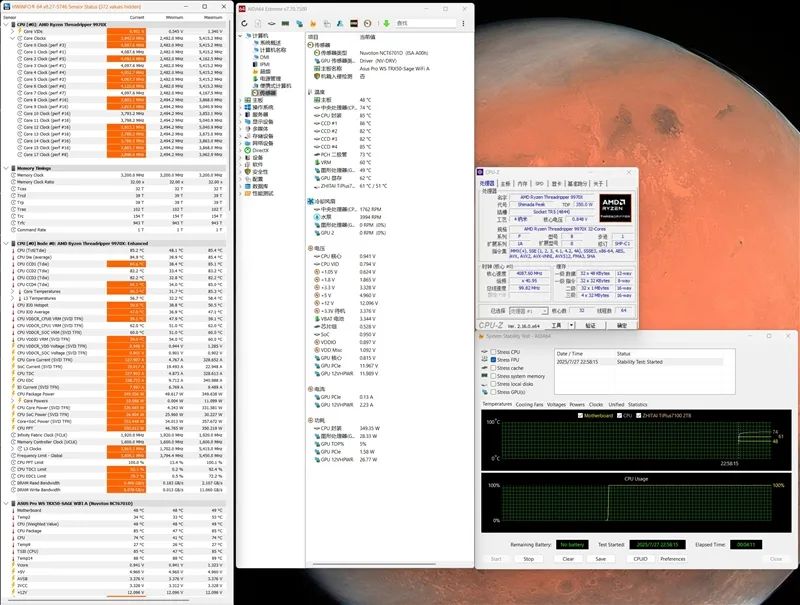
The ThreadRipper 9970X can maintain a stable stress test power consumption of 350W under default settings. During the stress test, the all-core frequency is around 3.8GHz, with a core temperature of 85°C.
2. PBO Enabled Stress Test
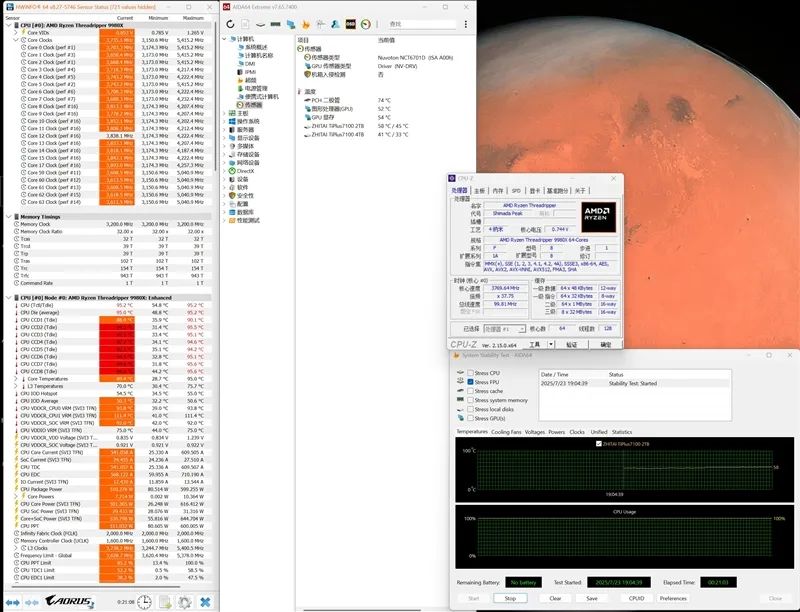
When unlocking the power consumption to 700W for the stress test and using an 850W power supply, the system directly restarted. The problem was resolved after switching to the Segotep Kunlun Jiuzhong KE-1300P Platinum digital power supply.
Using AIDA64 FPU for a 20-minute stress test, with the ThreadRipper 9980X limited by the 95°C temperature wall, the power consumption stabilizes at 510W. The previous generation ThreadRipper 7980X can stably maintain 550W for extended periods.
We repeatedly applied thermal paste multiple times with similar results, indicating that the power consumption with PBO enabled is approximately 40W lower than that of the previous generation ThreadRipper 7980X.
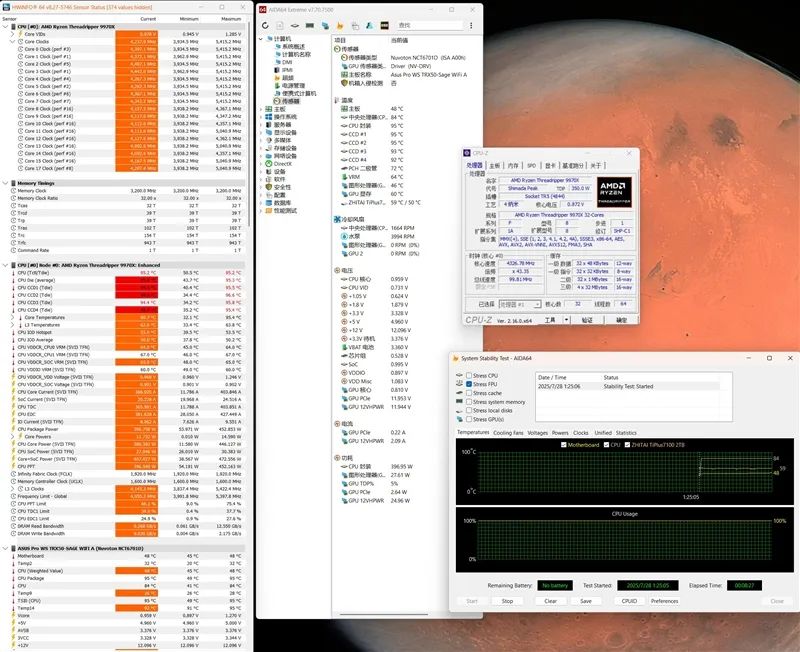
After stressing the ThreadRipper 9970X for 12 minutes, with the ThreadRipper 9970X limited by the 95°C temperature wall, the power consumption is maintained at around 400W. During the stress test, the all-core frequency is 4.1~4.2GHz.
3. All-Core Frequency
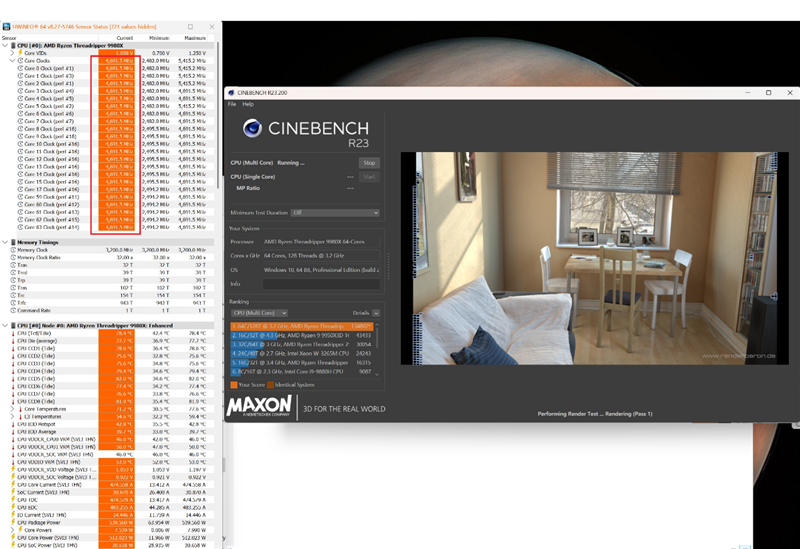
The ThreadRipper 9980X has a boost frequency of 5.4GHz. When we slightly reduce the load, we can see that when all cores are active, the all-core frequency is 4.7GHz.
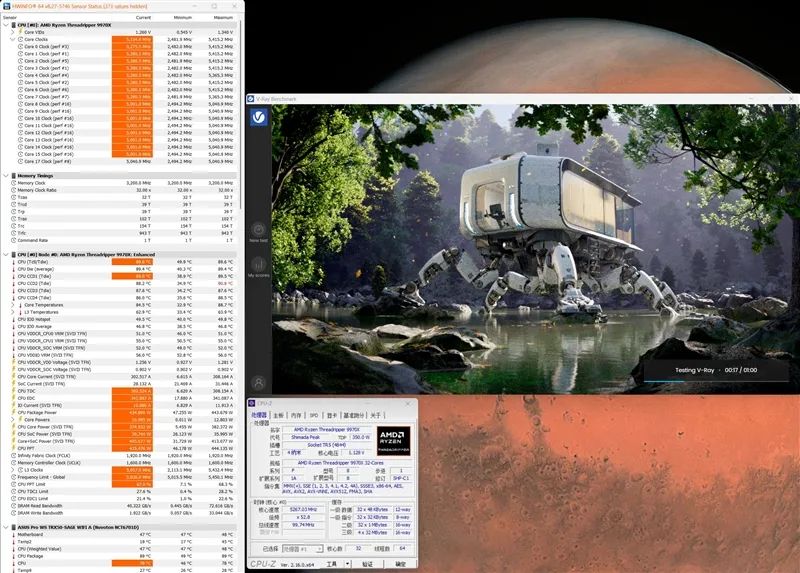
The situation with the ThreadRipper 9970X is somewhat different. When all 32 cores have a load, some CCDs can stably maintain all cores at 5.3GHz, while others have a core frequency of 5.0GHz. Both are significantly higher than the ThreadRipper 9980X.
In other words, to run the ThreadRipper 9980X at 5.0GHz, overclocking is necessary. In contrast, the ThreadRipper 7970X can exceed 5.0GHz at its default frequency under temperature-controlled conditions.
P.s. When all cores of the previous generation ThreadRipper 7980X are fully loaded, the all-core frequency is 4.8GHz, which is 100MHz higher than the ThreadRipper 9980X.
The all-core frequency of the ThreadRipper 7980X is also 4.8GHz, which is 300~500MHz lower than the ThreadRipper 9970X.
4. Frequency Comparison at the Same Power Consumption
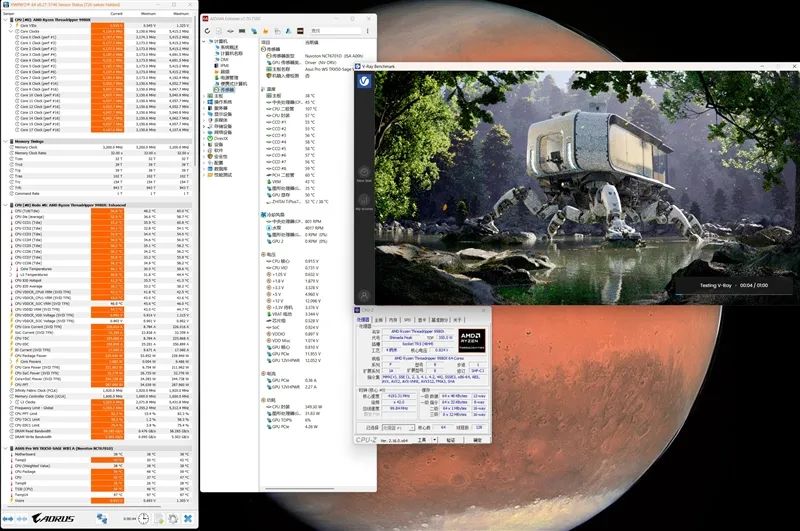
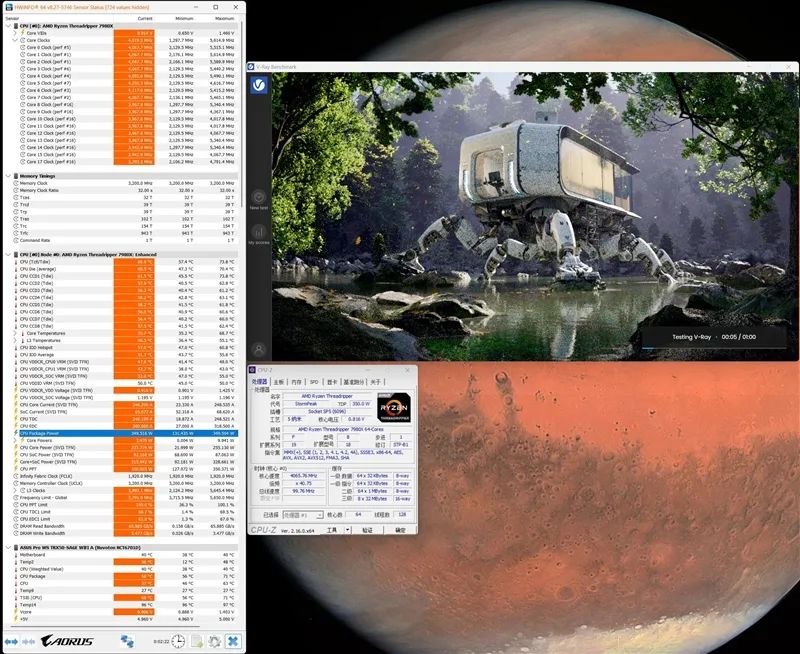
Locking the power consumption at 350W to run V-ray Benchmark 6.0, at the 4~5-second mark, the frequency of the ThreadRipper 9980X is approximately 100MHz higher than that of the ThreadRipper 7980X.
V. Theoretical Performance Tests
1. AIDA64 GPGPU
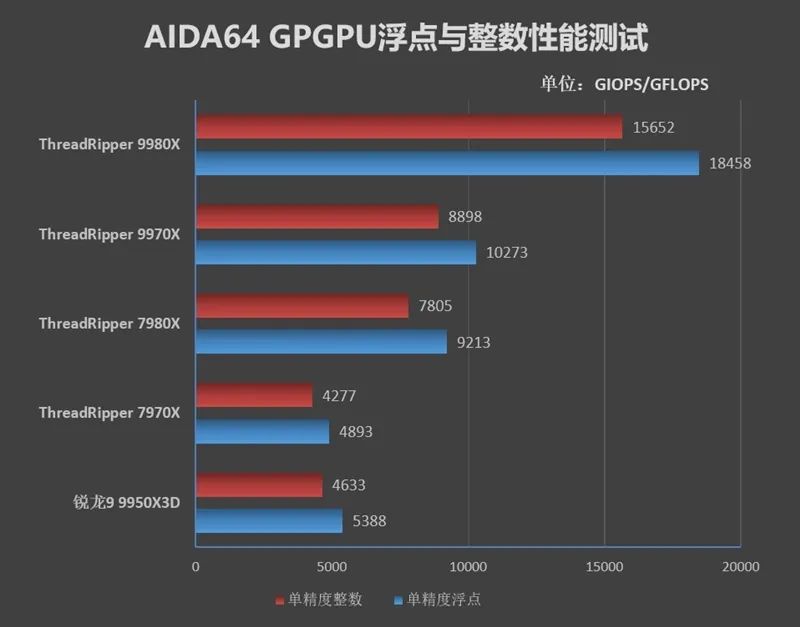
2. CPU-Z
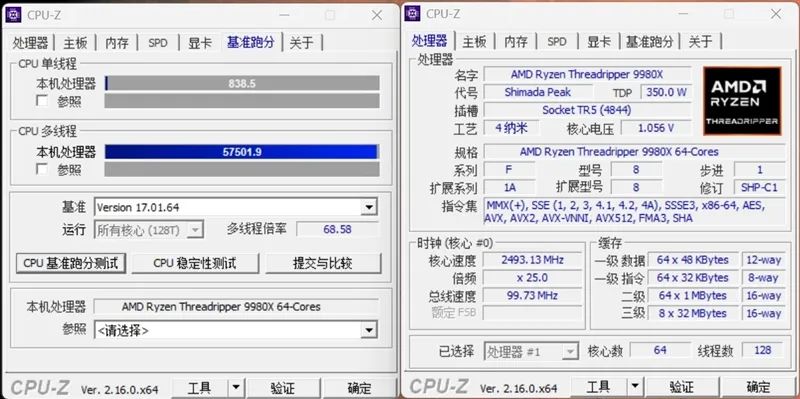
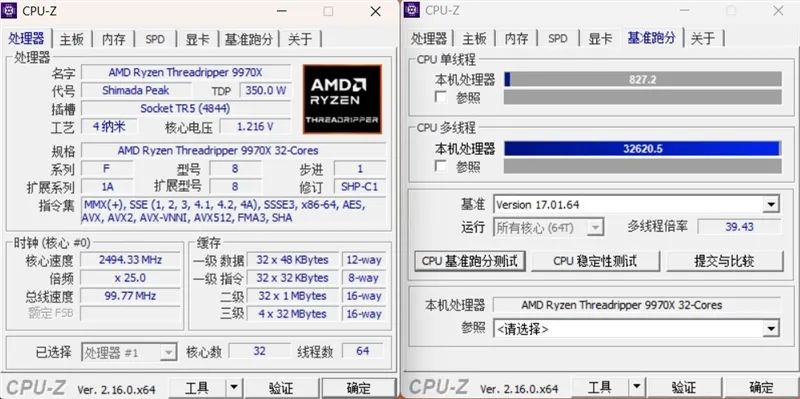
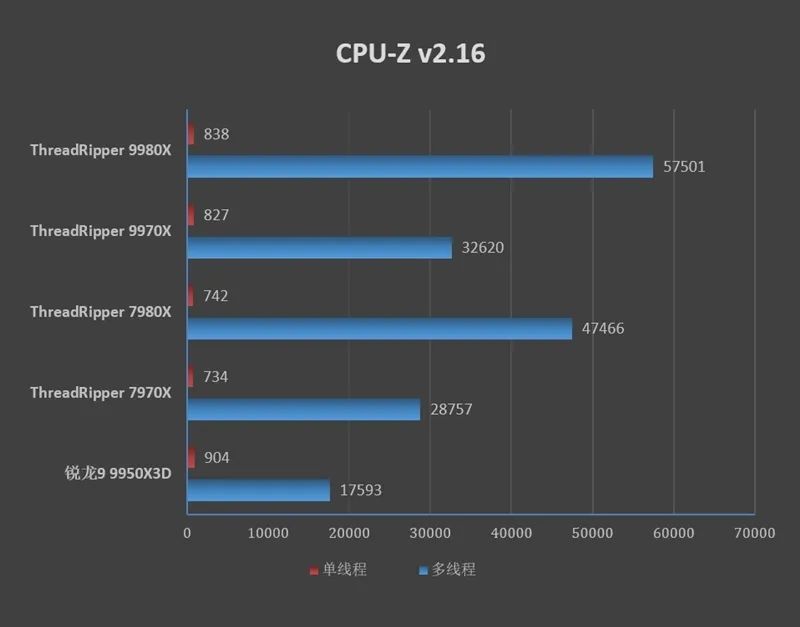
3. CineBench R15
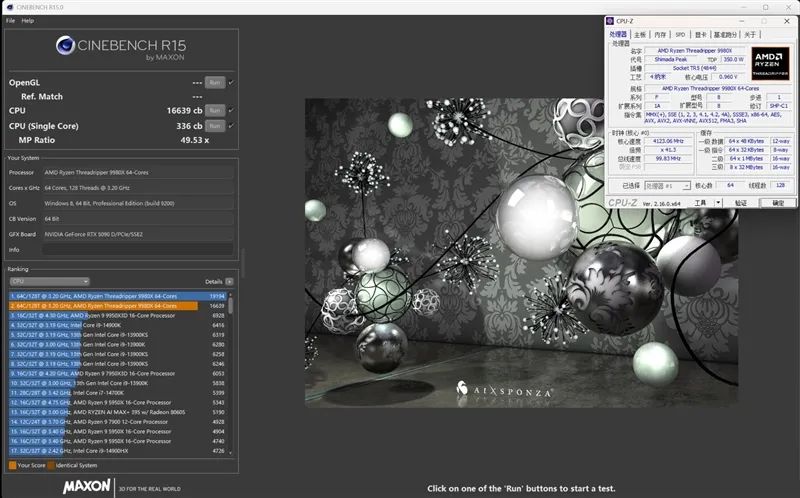
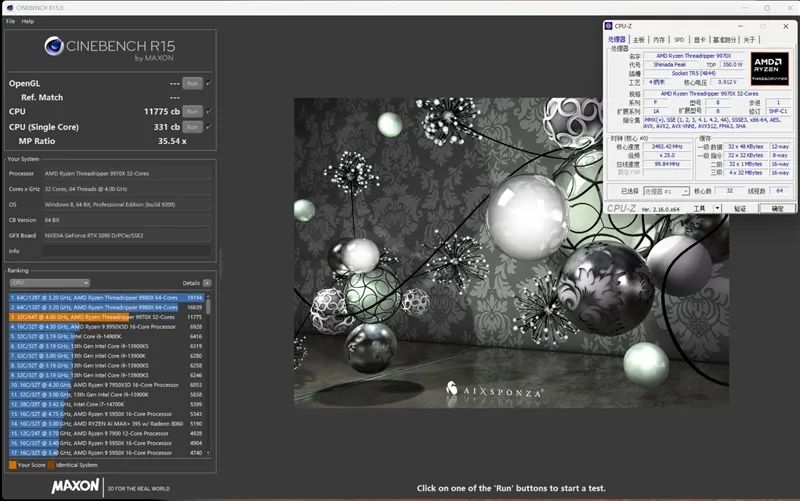
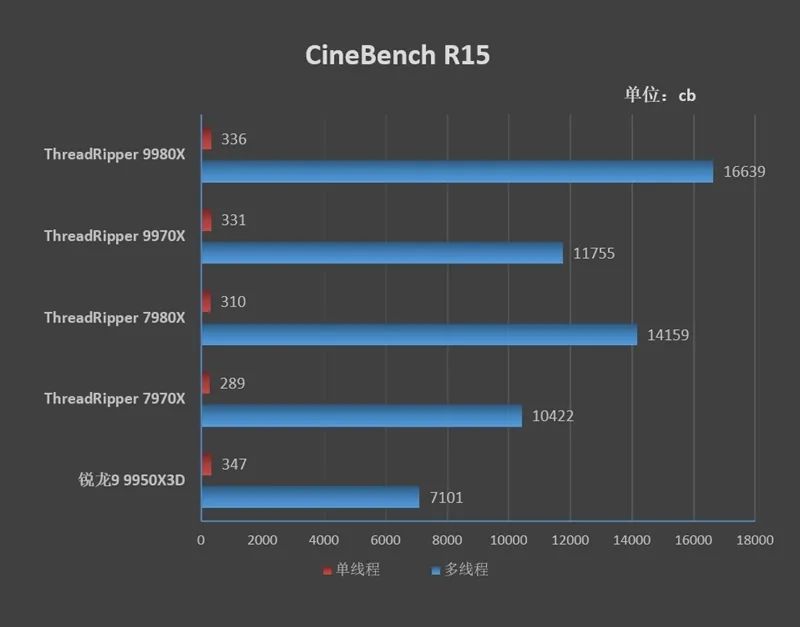
4. CineBench R20
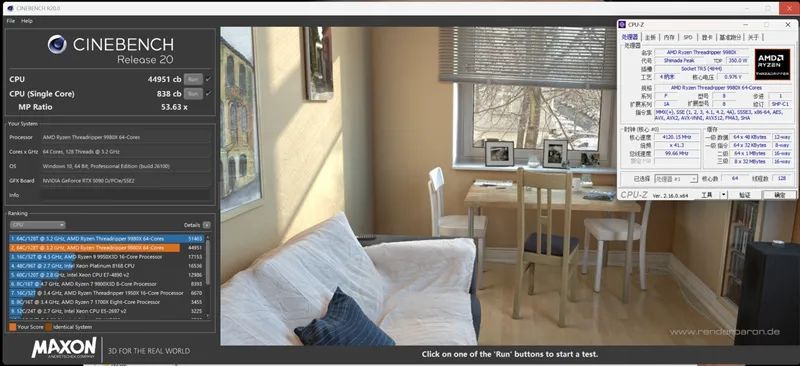
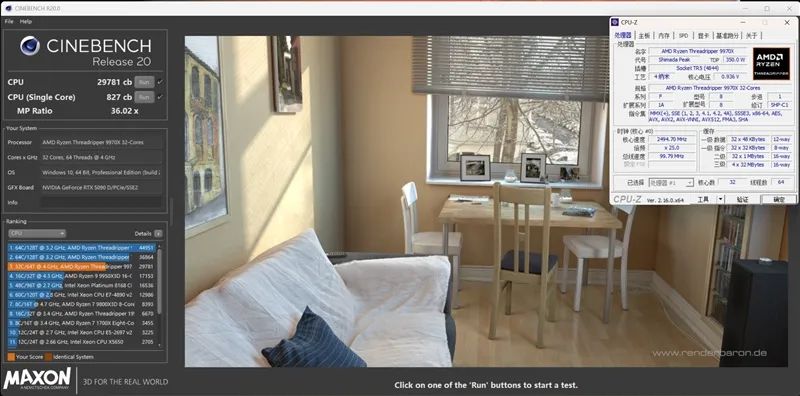
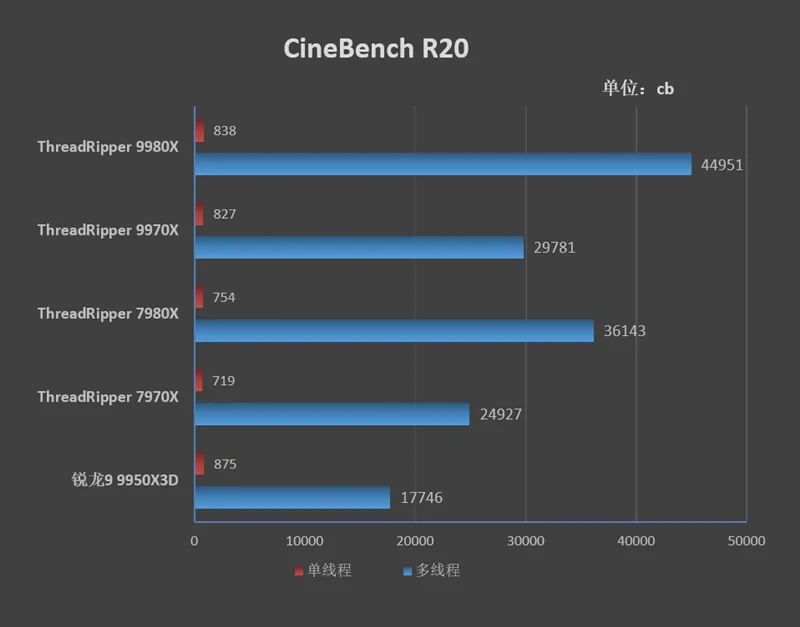
5. CineBench R23
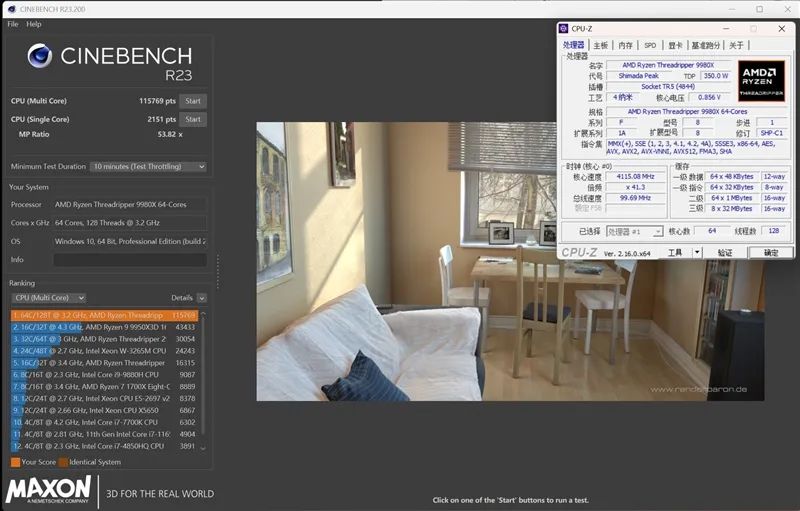
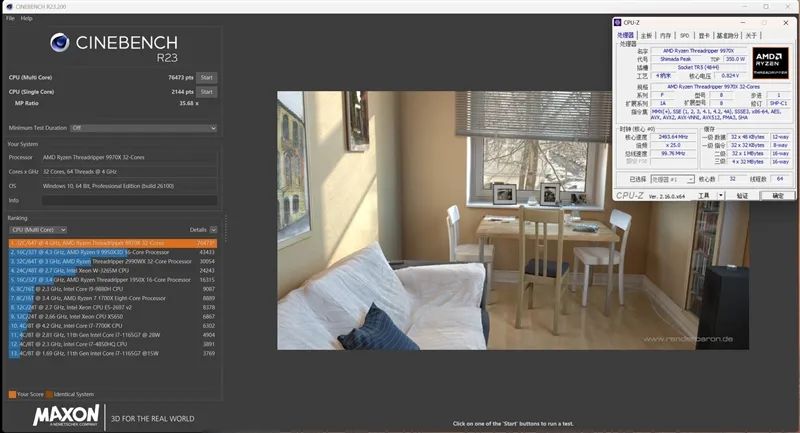
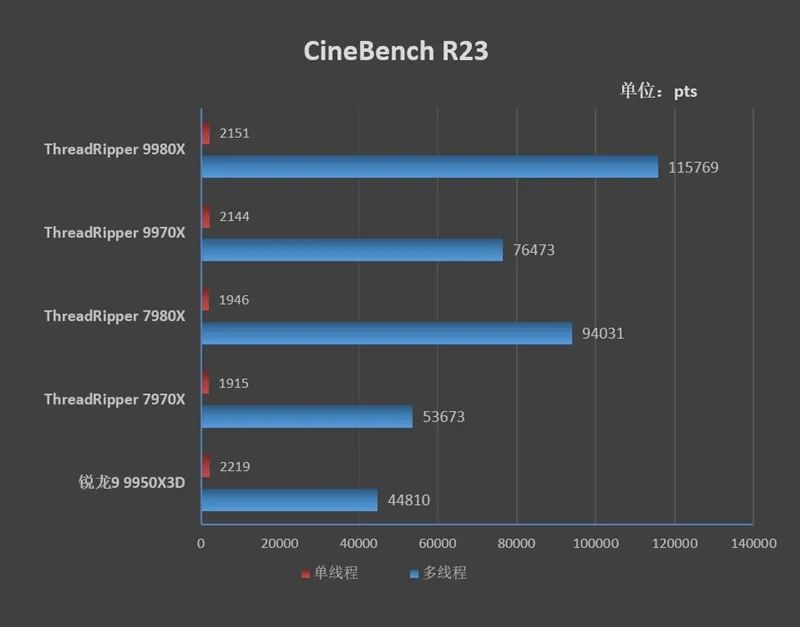
6. CineBench 2024
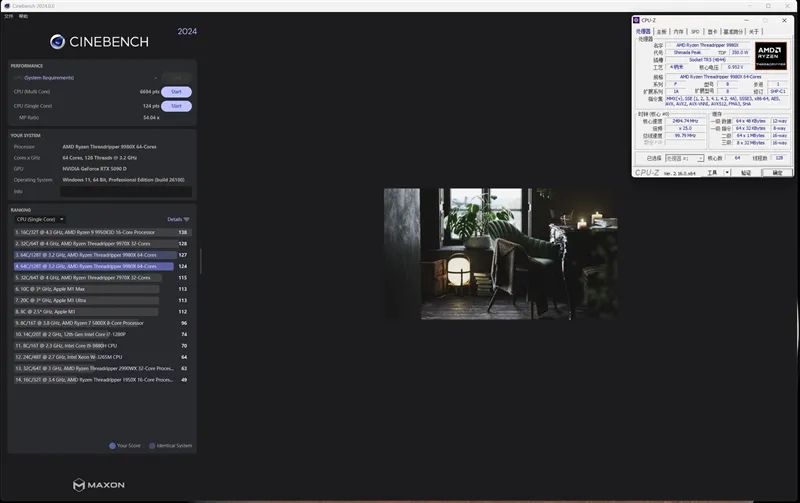
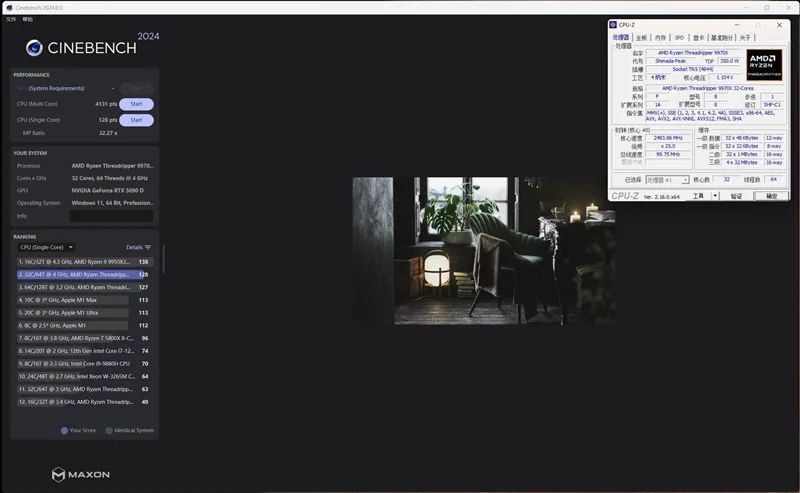
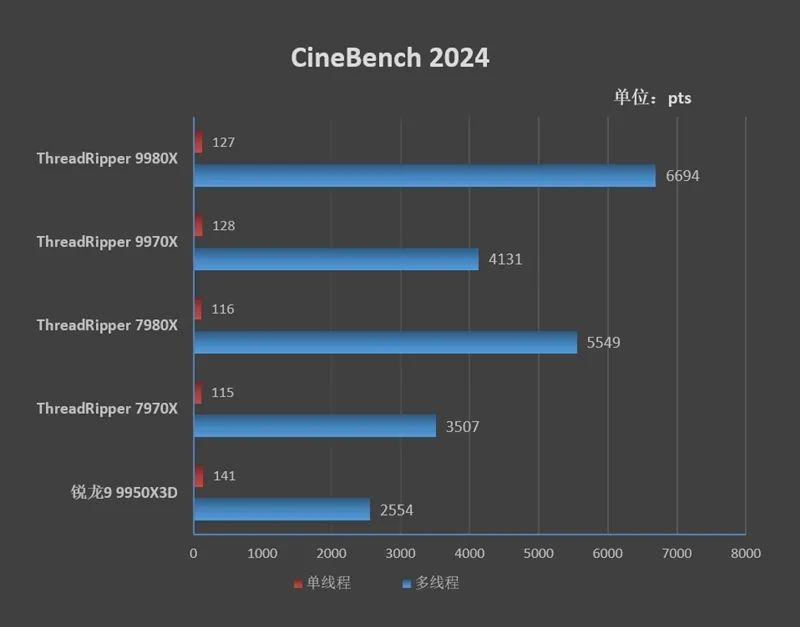
7. 7-Zip
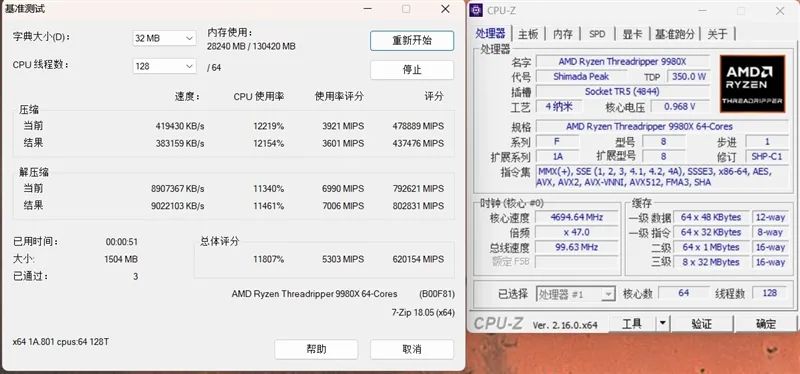
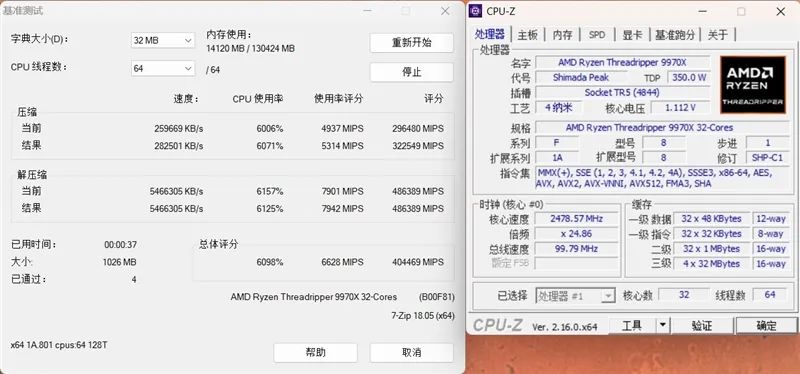
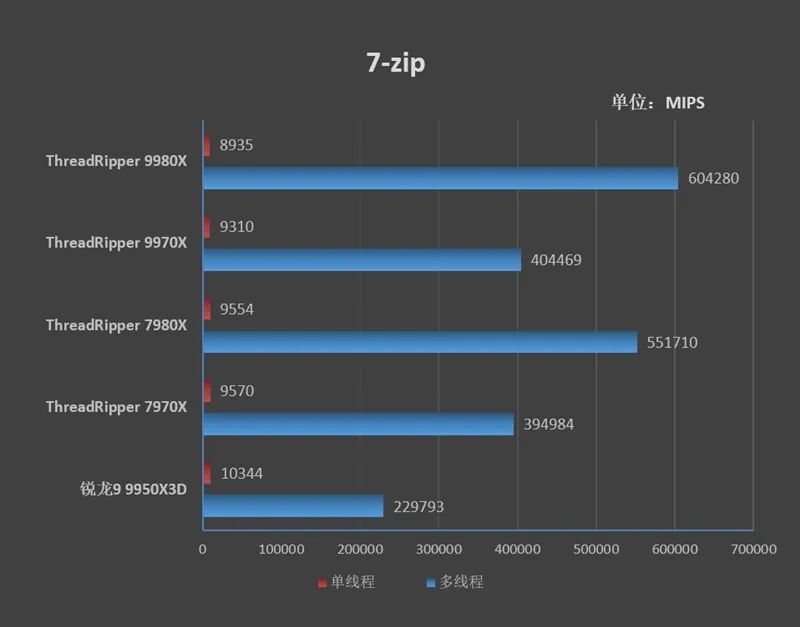
8. PassMark
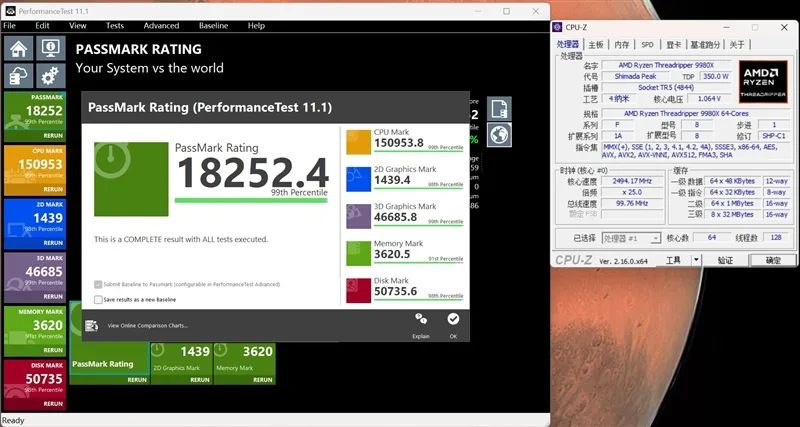
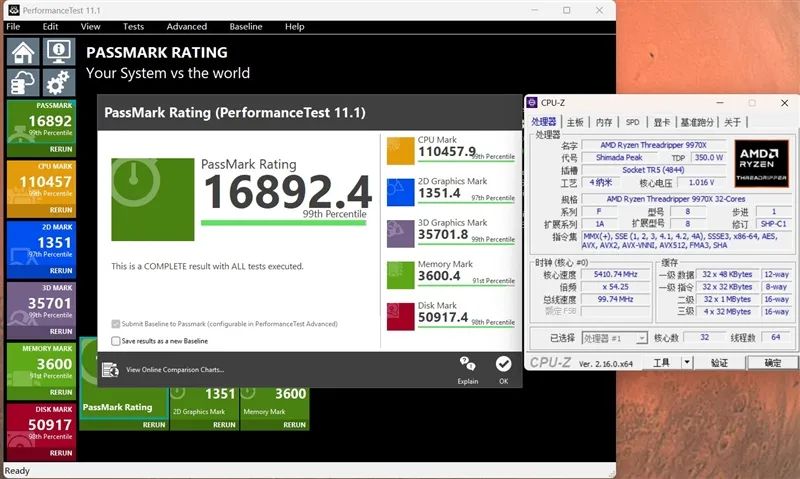
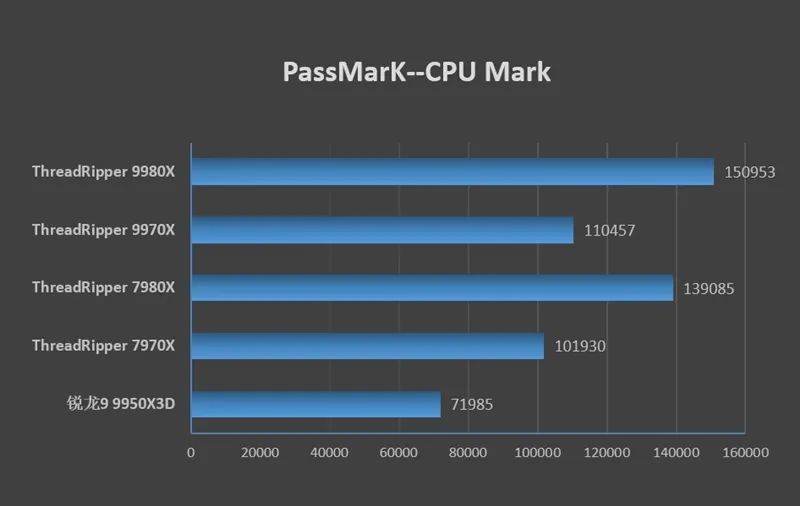
9, Memory Cache Test
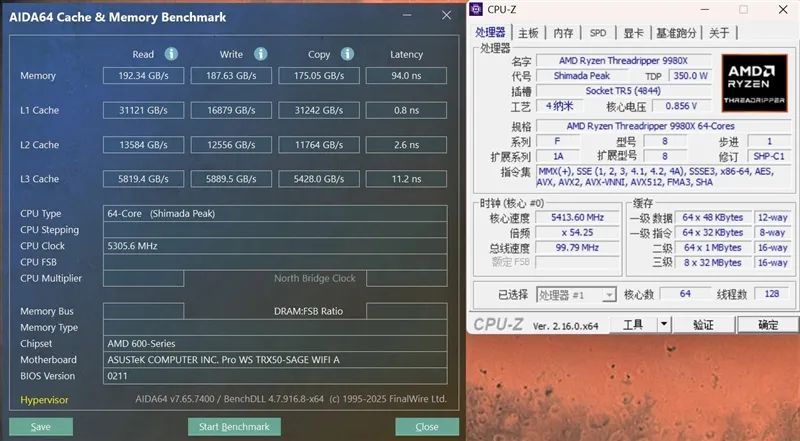
This is the result of the Threadripper 9980X, with read, write, and copy bandwidths of 192GB/s, 187GB/s, and 175GB/s, respectively, and a latency of 94ns.
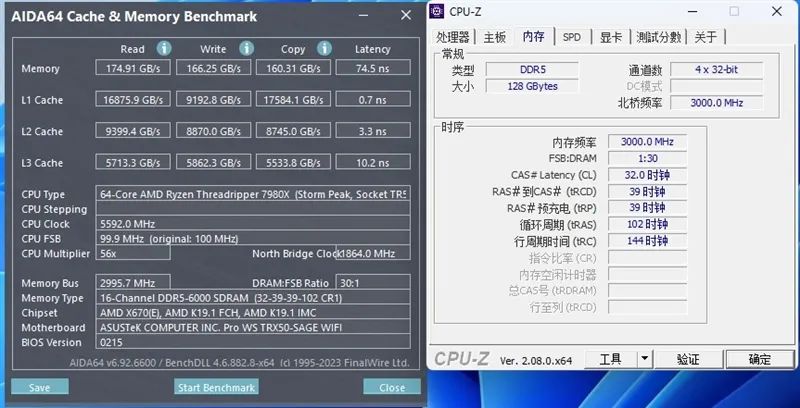
This is the result of the Threadripper 7980X, with read, write, and copy bandwidths of 174GB/s, 166GB/s, and 160GB/s, respectively, and a latency of 74.5ns.
It can be seen that the read and write bandwidth of the Threadripper 9980X is much higher, but the latency is 20ns worse.
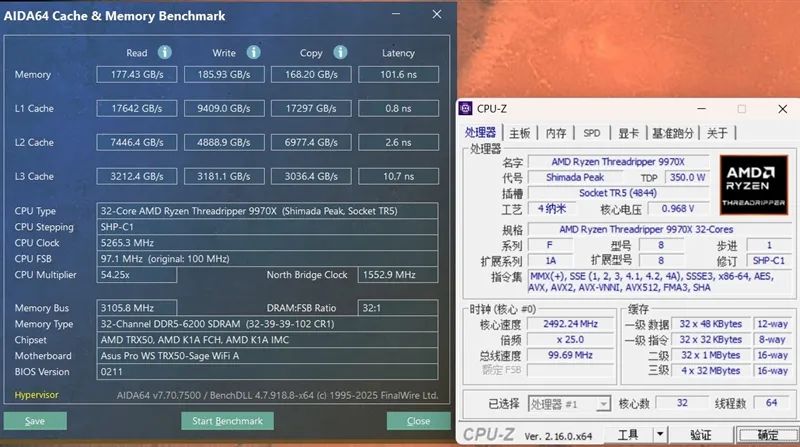
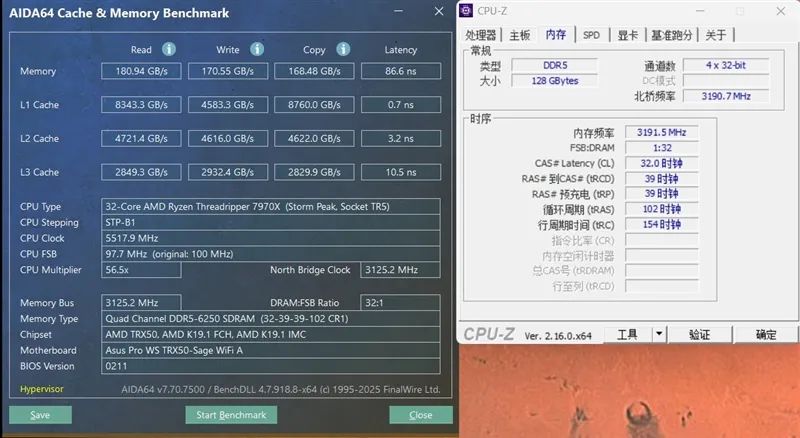
The 9970X also shows a similar situation, with a 15ns higher memory latency compared to the previous generation, and mixed results in read and write bandwidth.
VI. Productivity Performance Test
1. Blender Benchmark 4.5
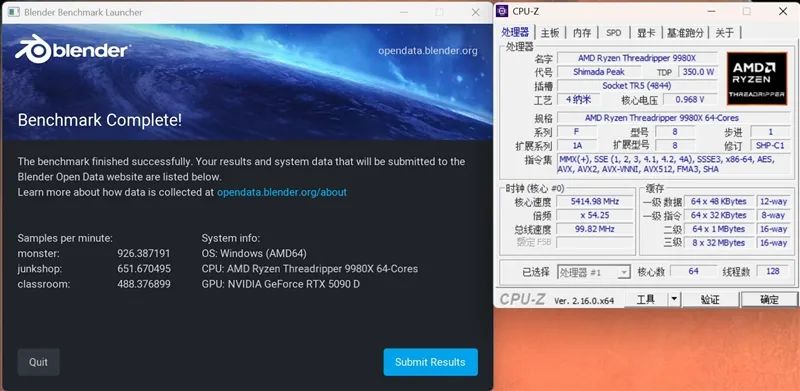
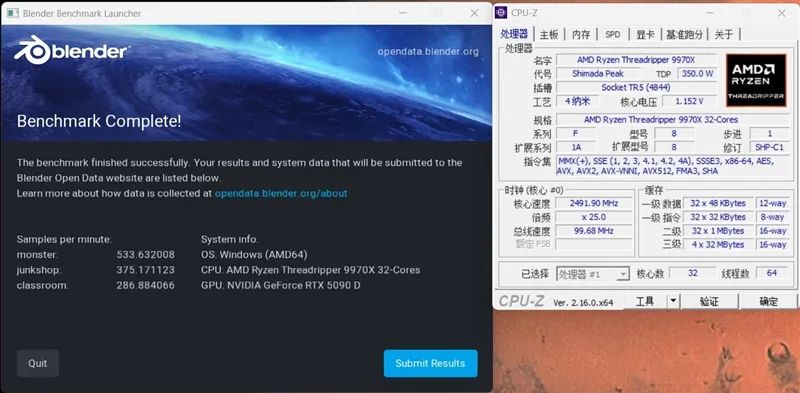
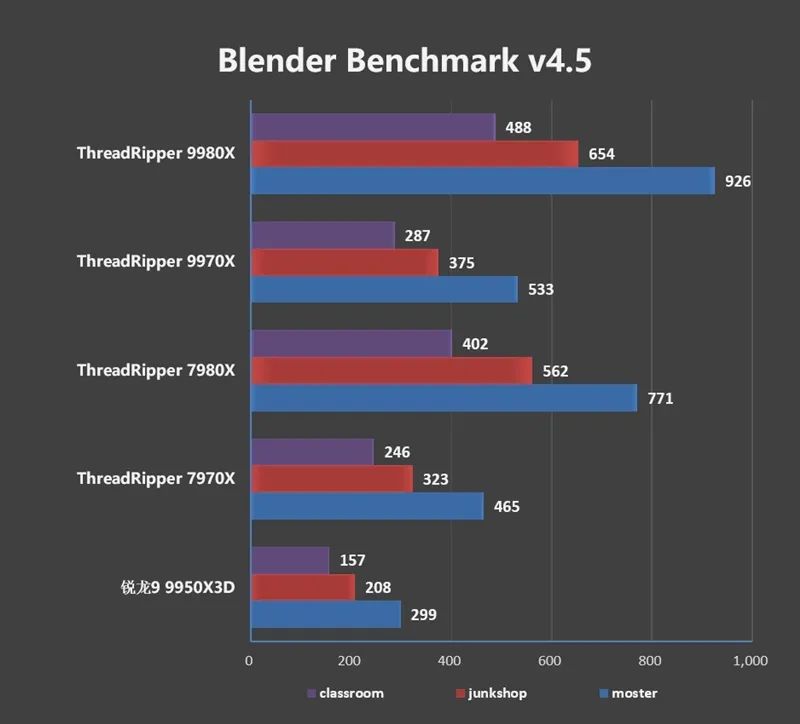
2. Corona 10 benchmark
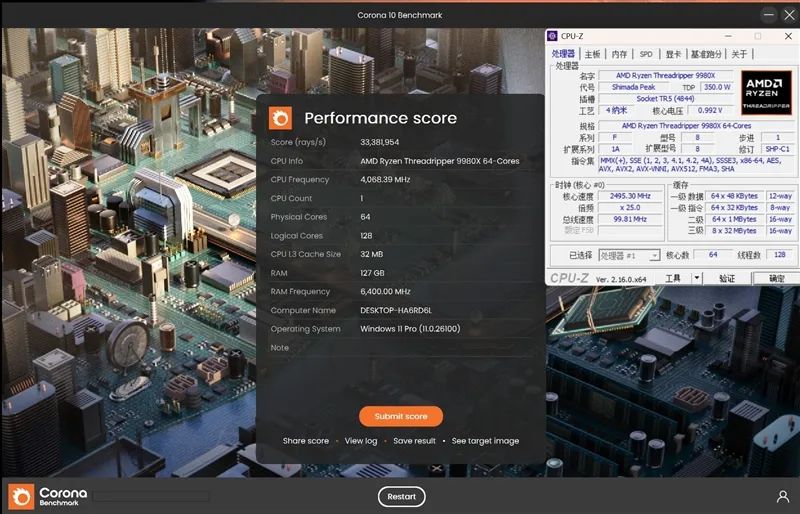
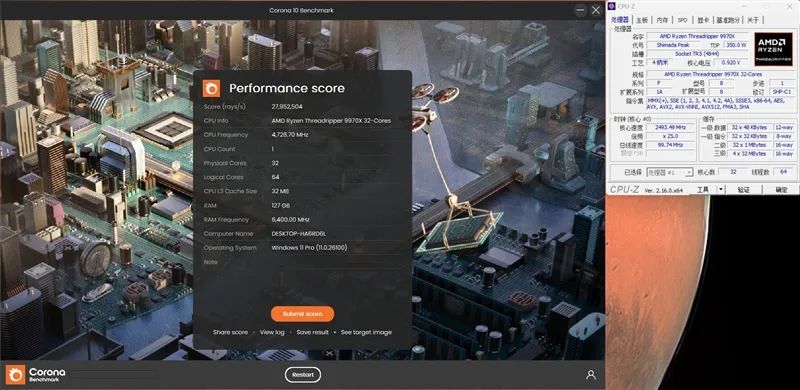
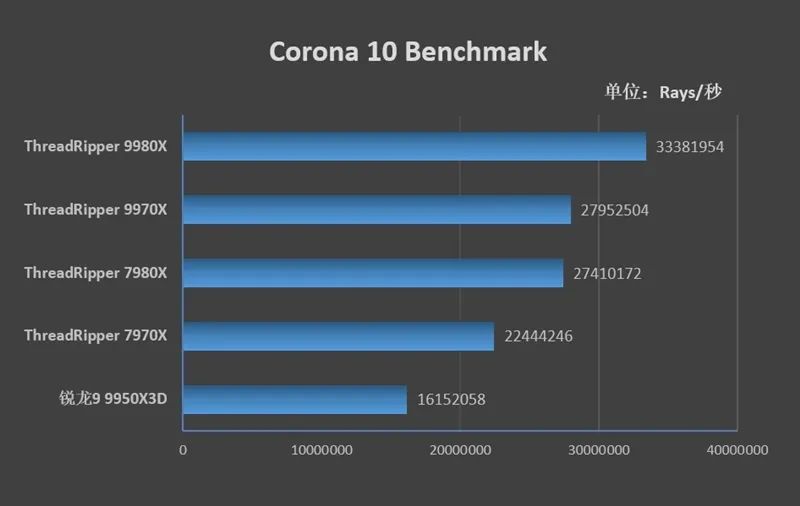
3. Handbrake
Handbrake is a very useful video encoding tool that can convert almost any format of video to today's standards. Slightly regrettably, this tool can only use up to 32 threads.
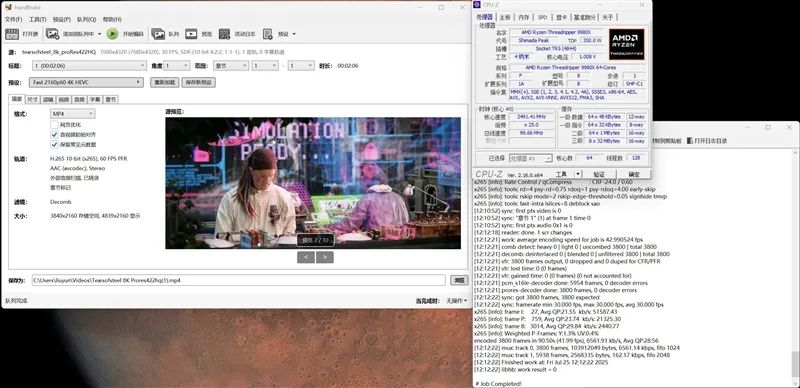
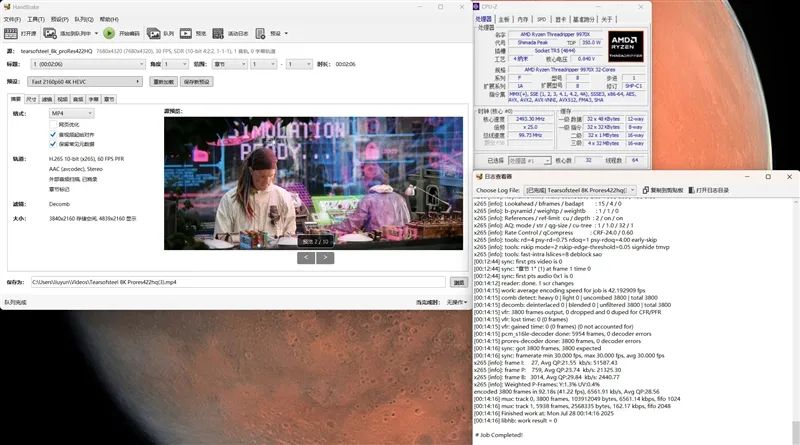
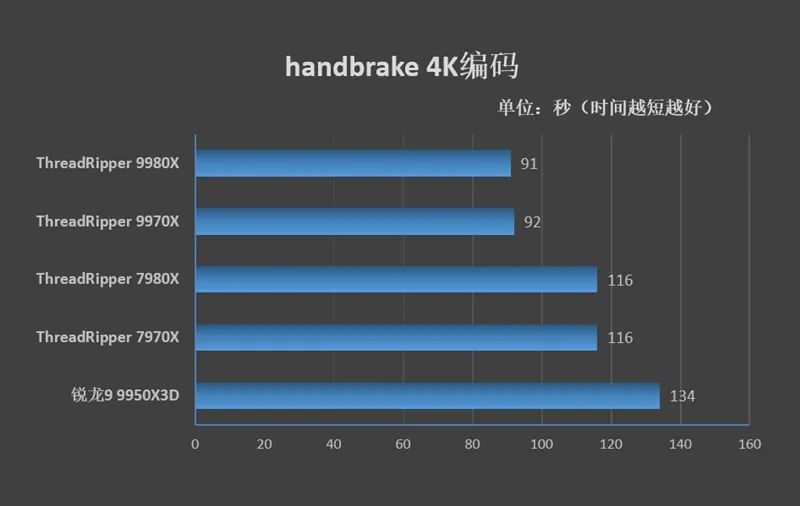
4. V-ray Benchmark 6.0
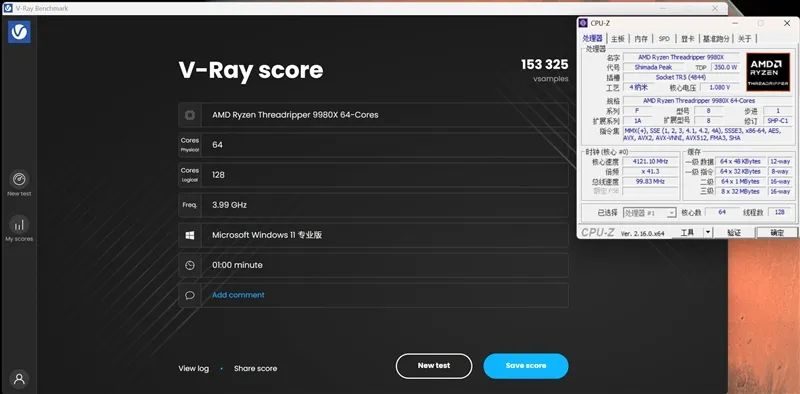
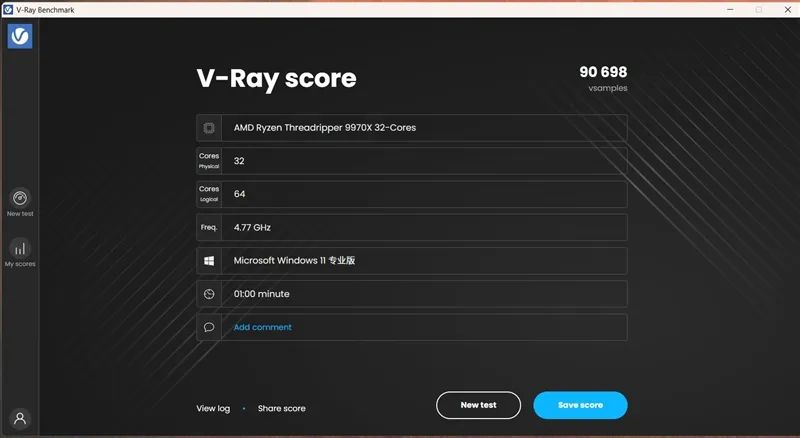
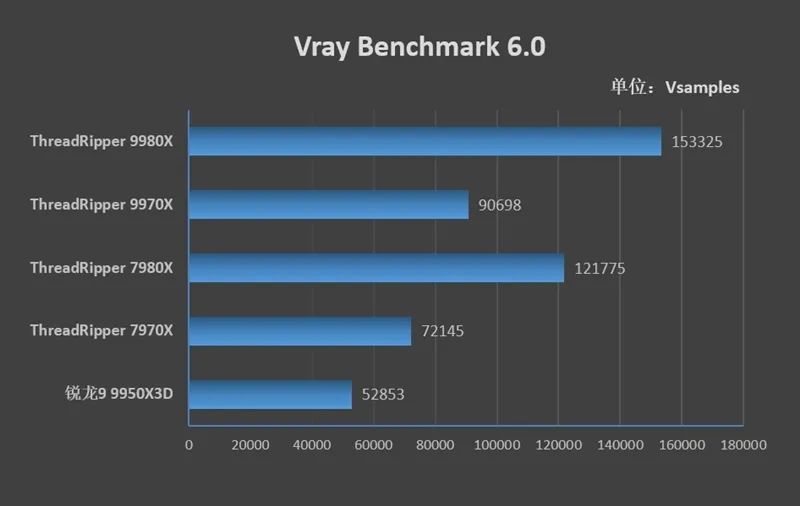
5. Indigo Benchmark
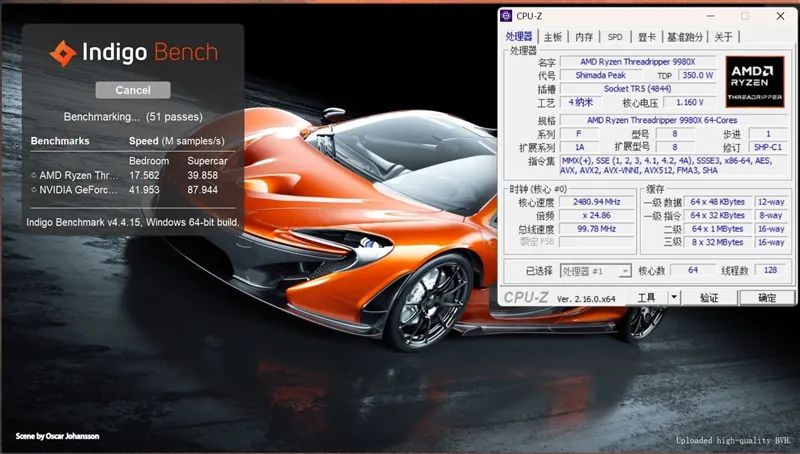
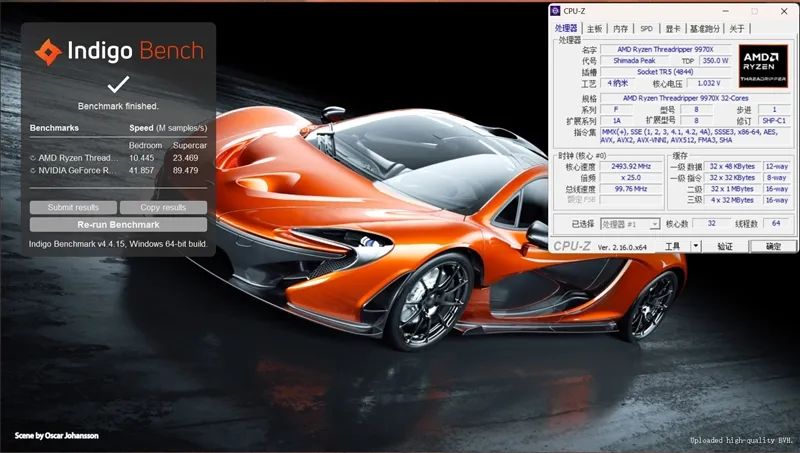
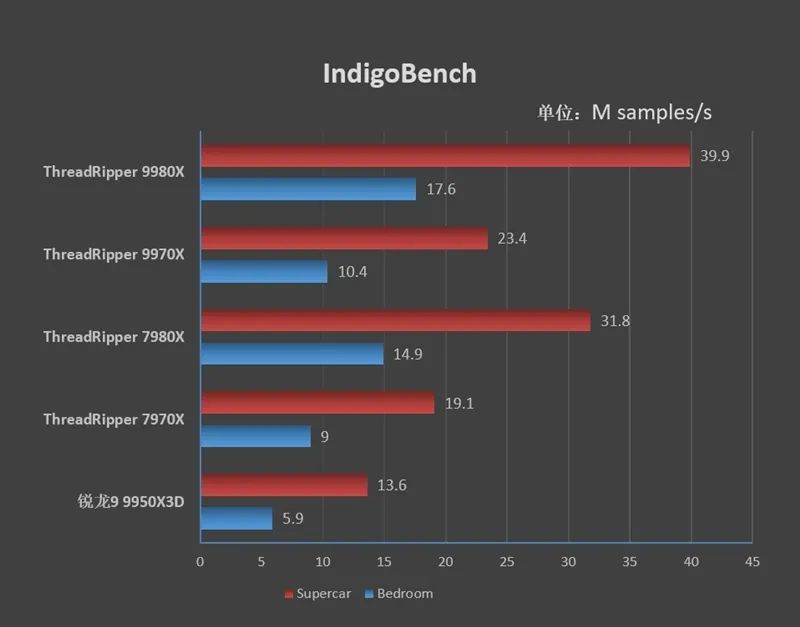
6. Blackmagic RAW Speed Test
Blackmagic RAW Speed Test is a tool software that tests the decoding capabilities of CPUs and GPUs. It can test the system's speed in decoding full-resolution Blackmagic RAW frames. This tool can use up to 48 threads.
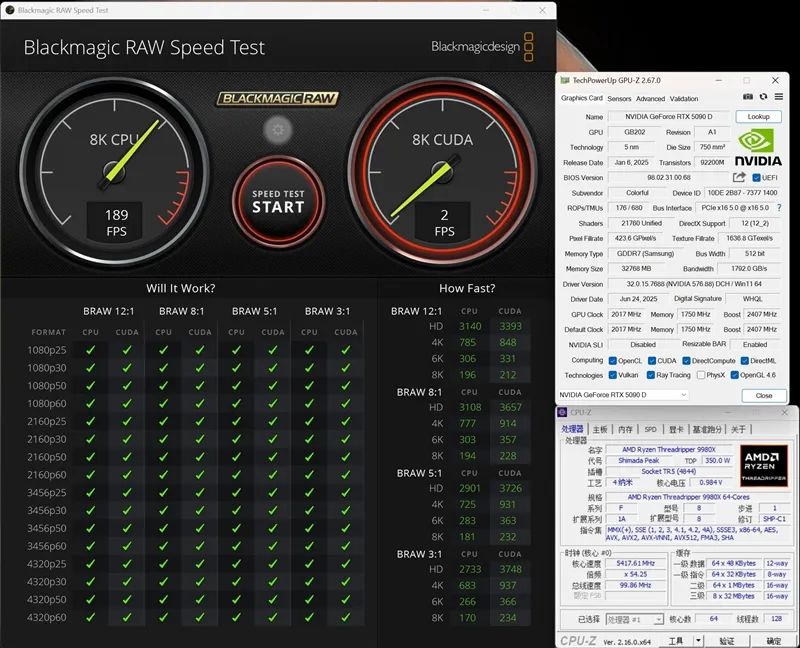
This tool simultaneously tested the decoding performance of the TR 9980X and RTX 5090. Surprisingly, the decoding capability of the TR 9980X is almost on par with that of the RTX 5090.
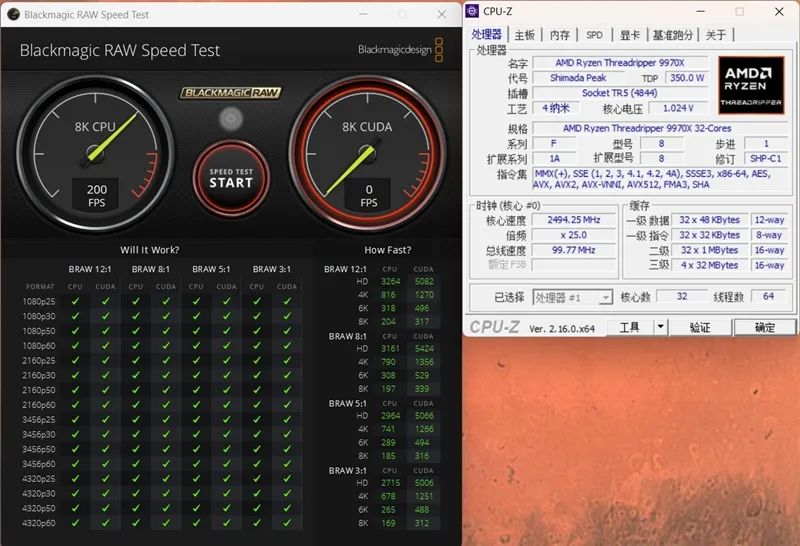
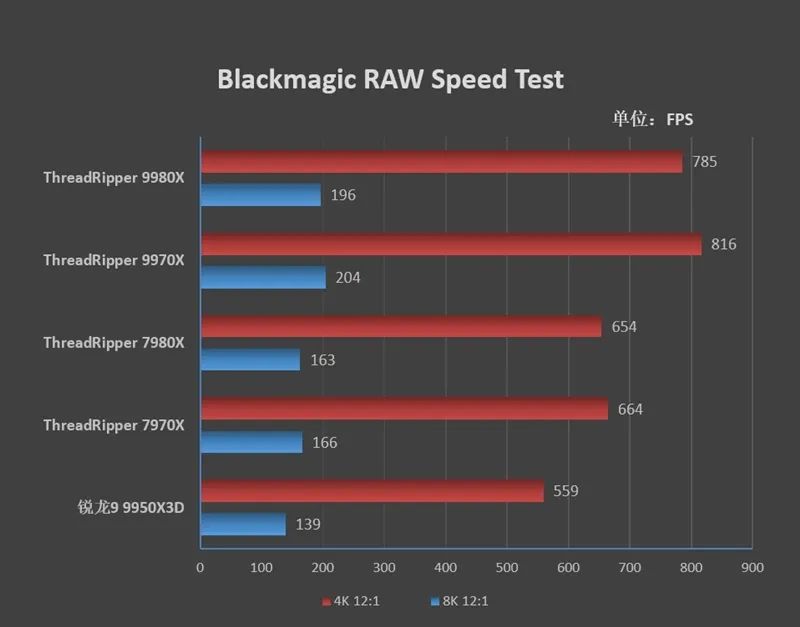
7. POV-Ray
POV-Ray is a testing software that uses ray tracing to render three-dimensional images. It is mainly used to test the processor's frame rate in generating images with ray tracing effects.
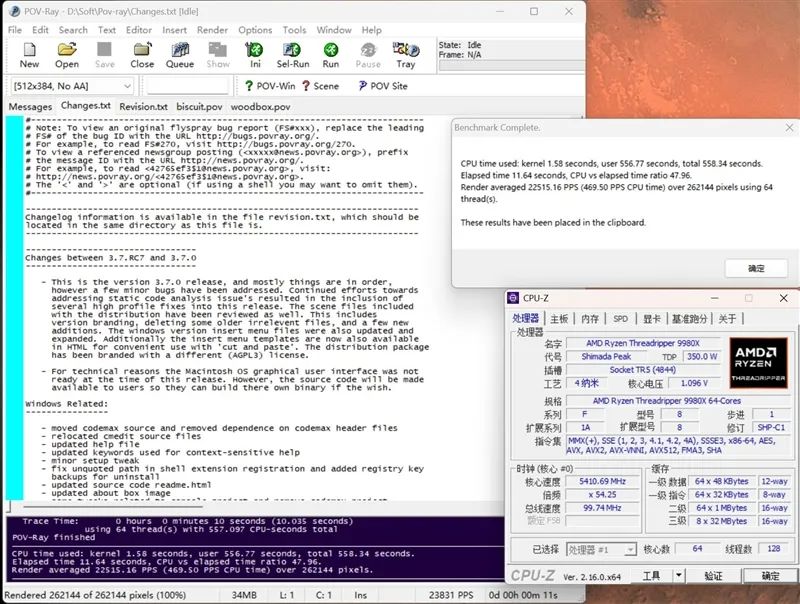
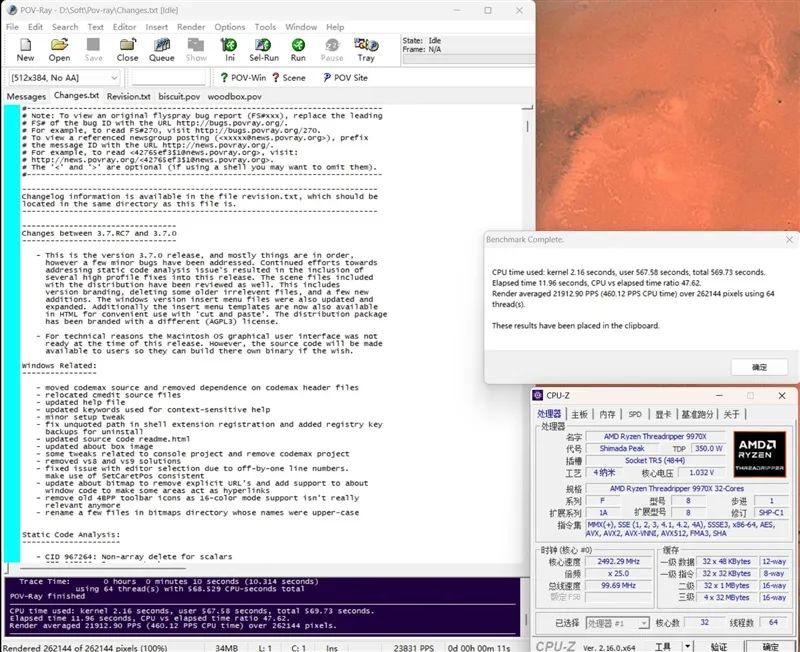
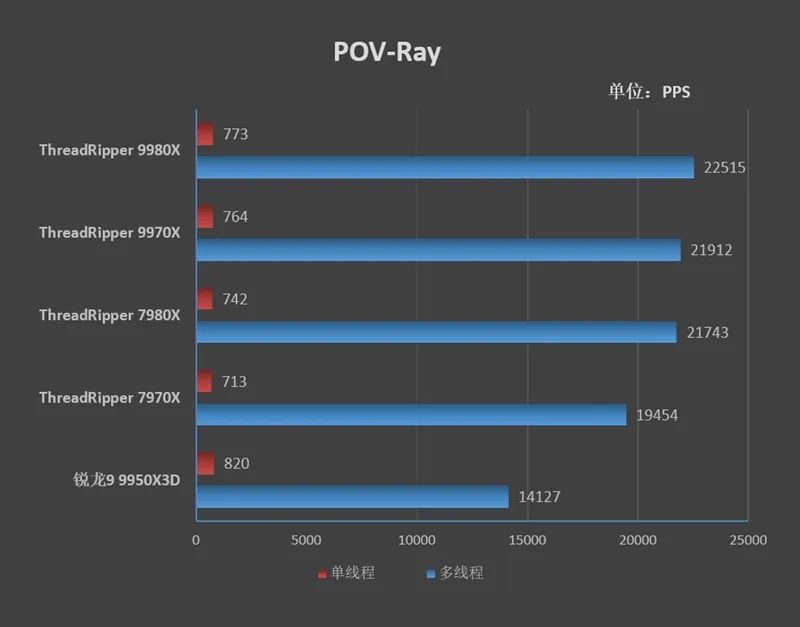
VII. Theoretical Performance with PBO Enabled
1. AIDA64 GPGPU
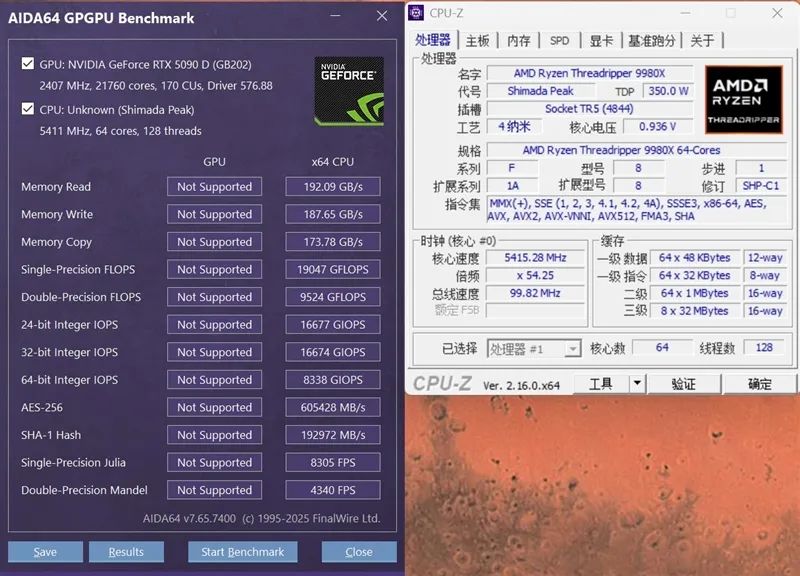
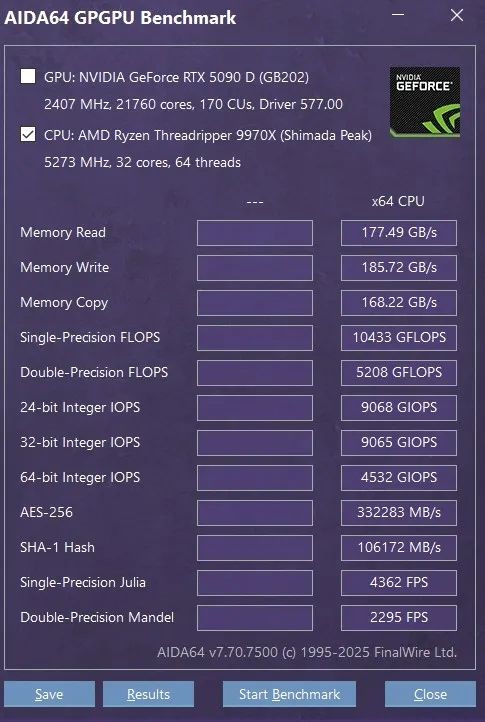
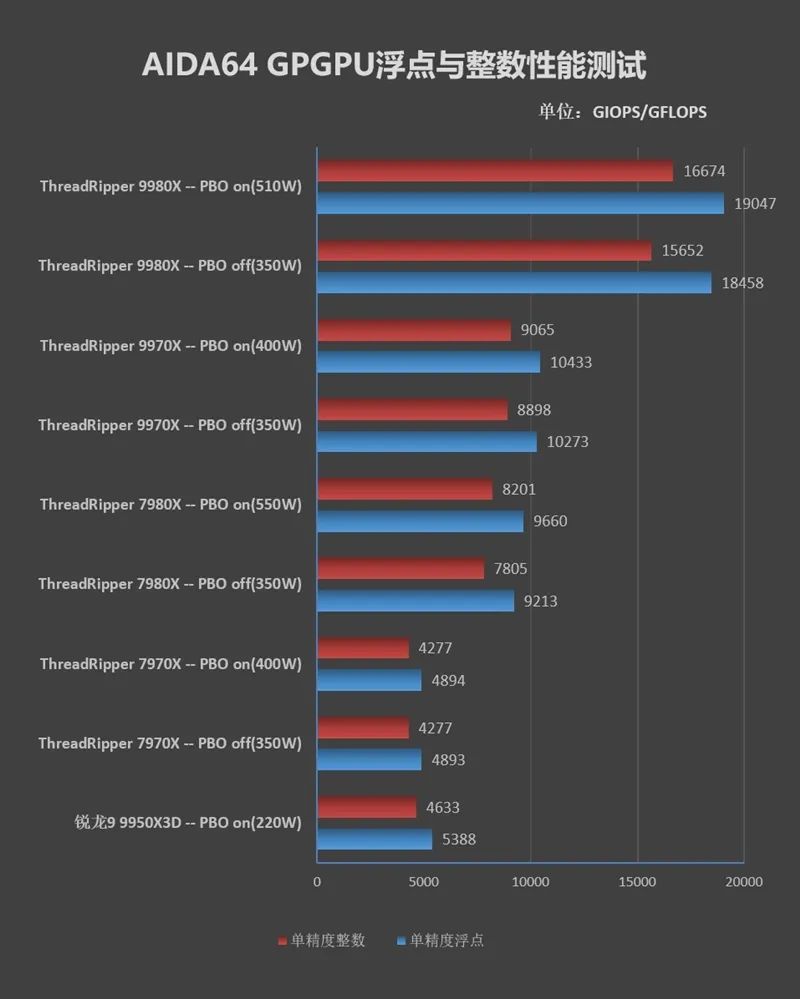
2. CPU-Z
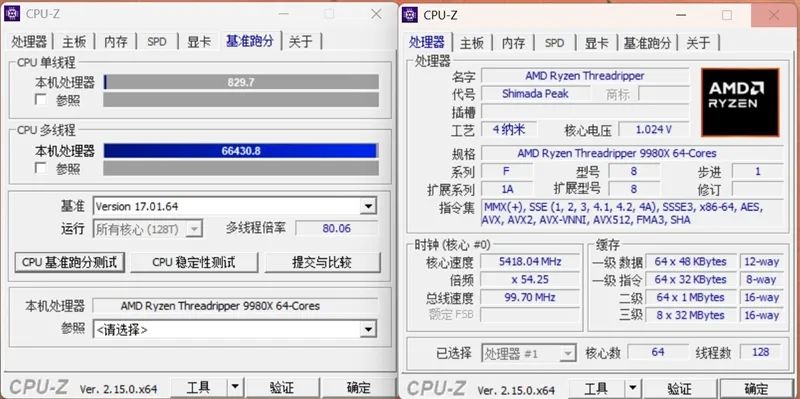
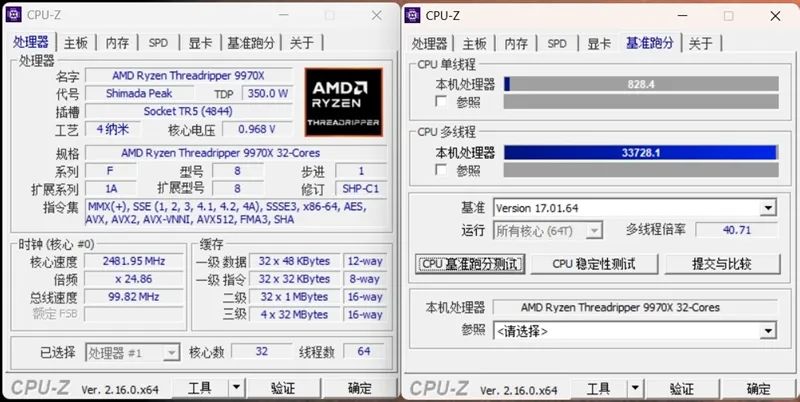
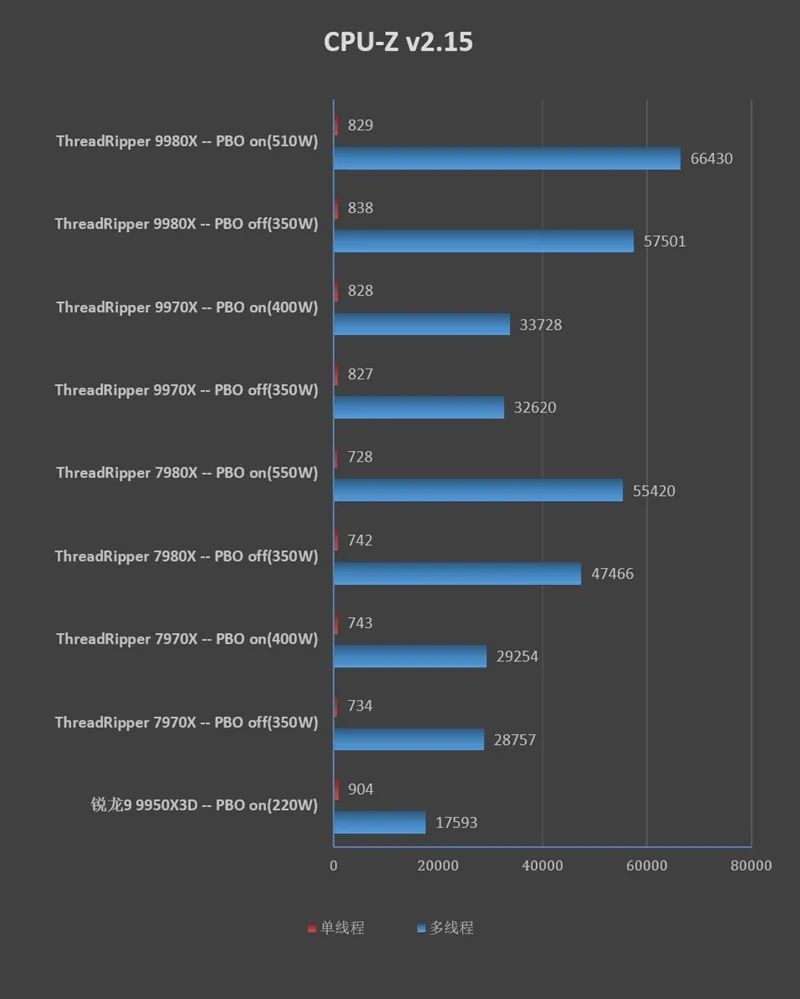
3. CineBench R15
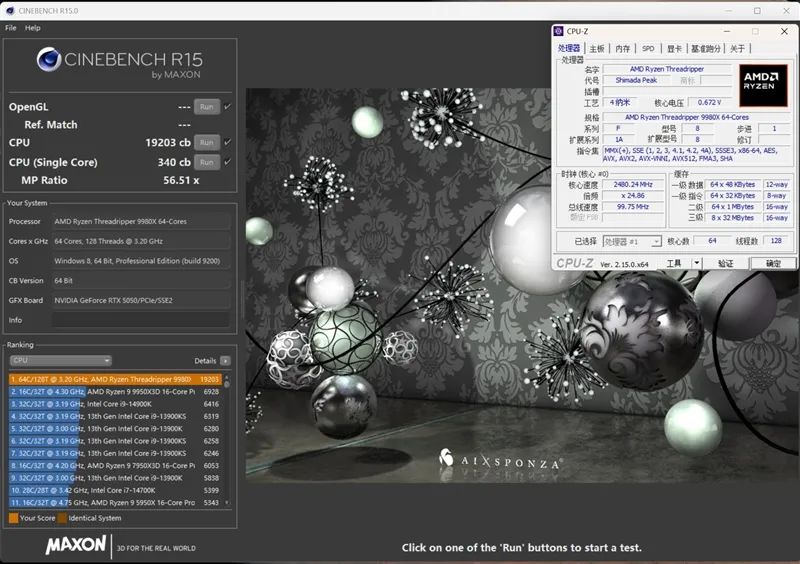
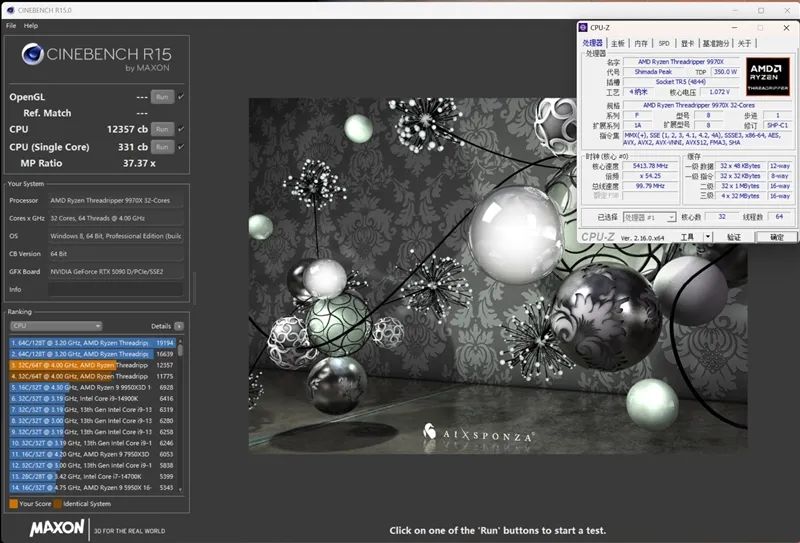
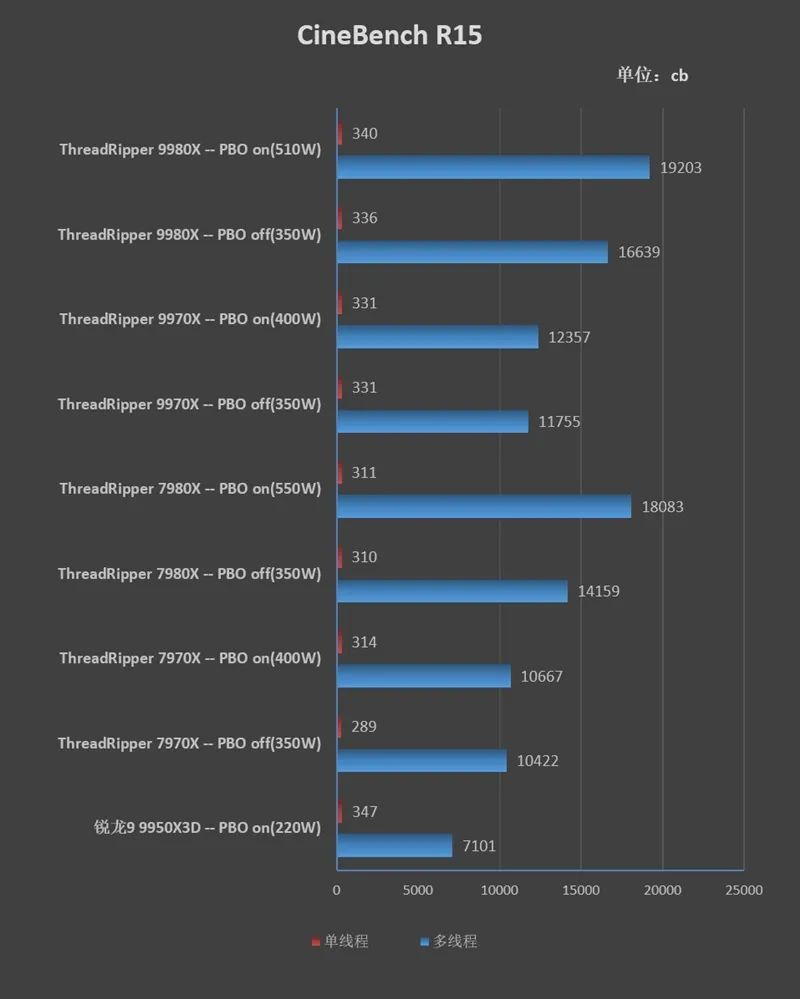
4. CineBench R20
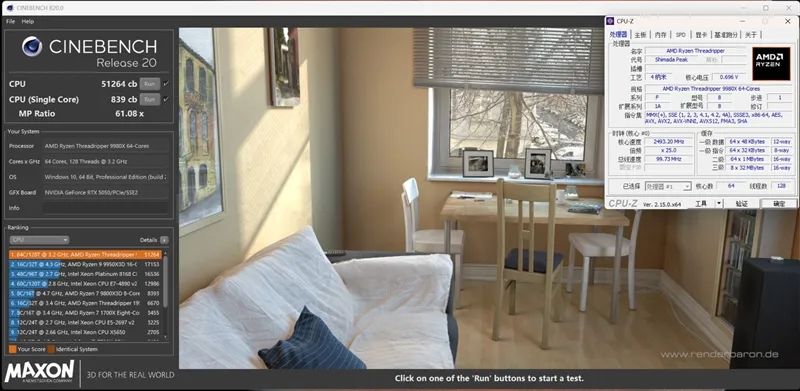
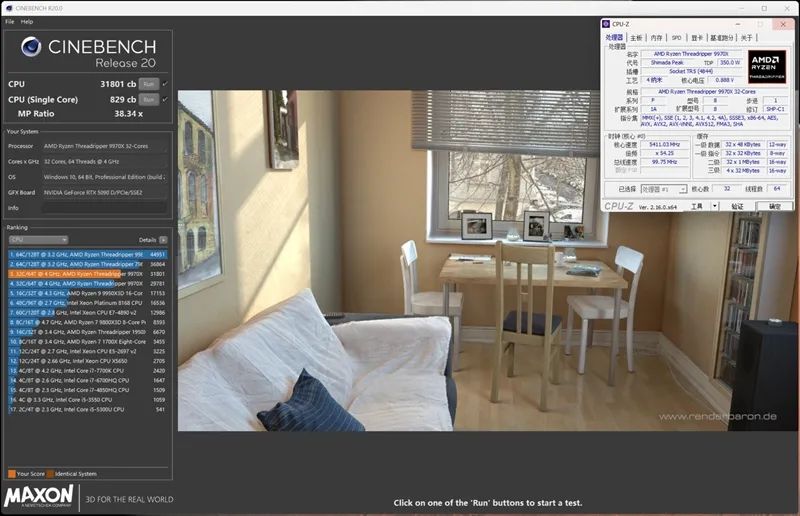
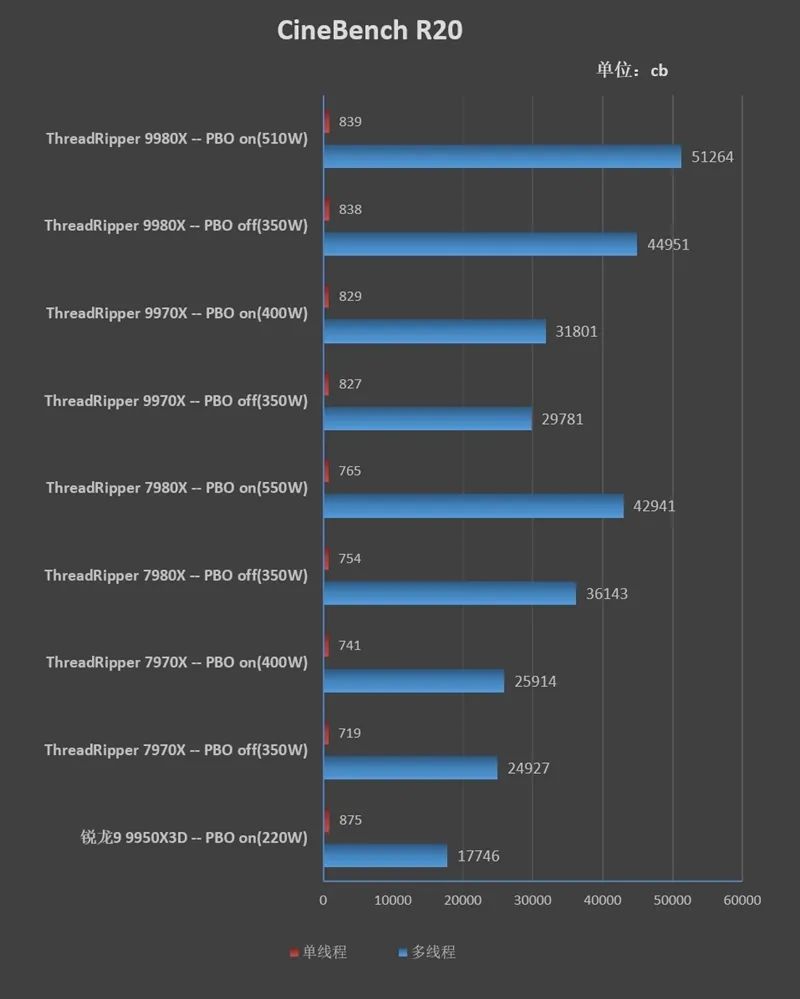
5, CineBench R23
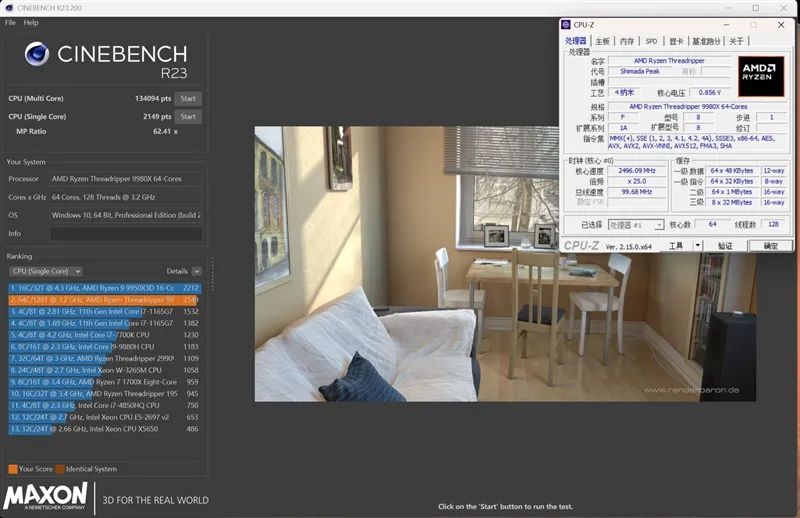
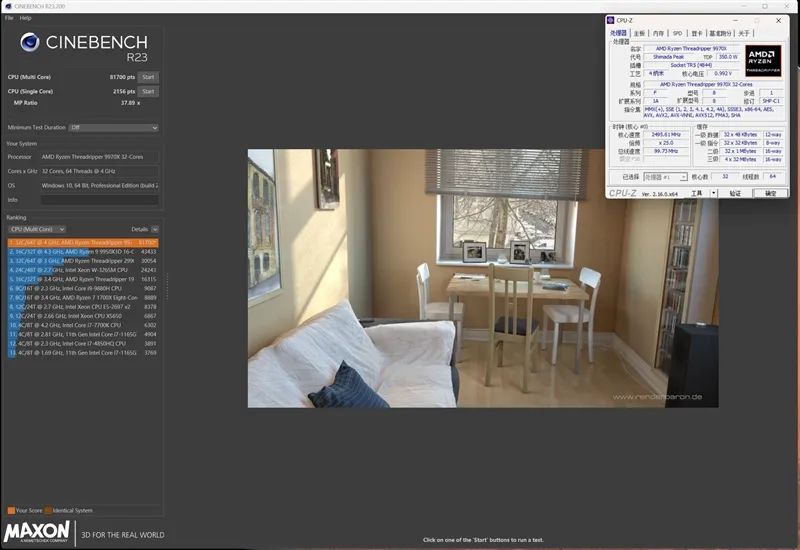
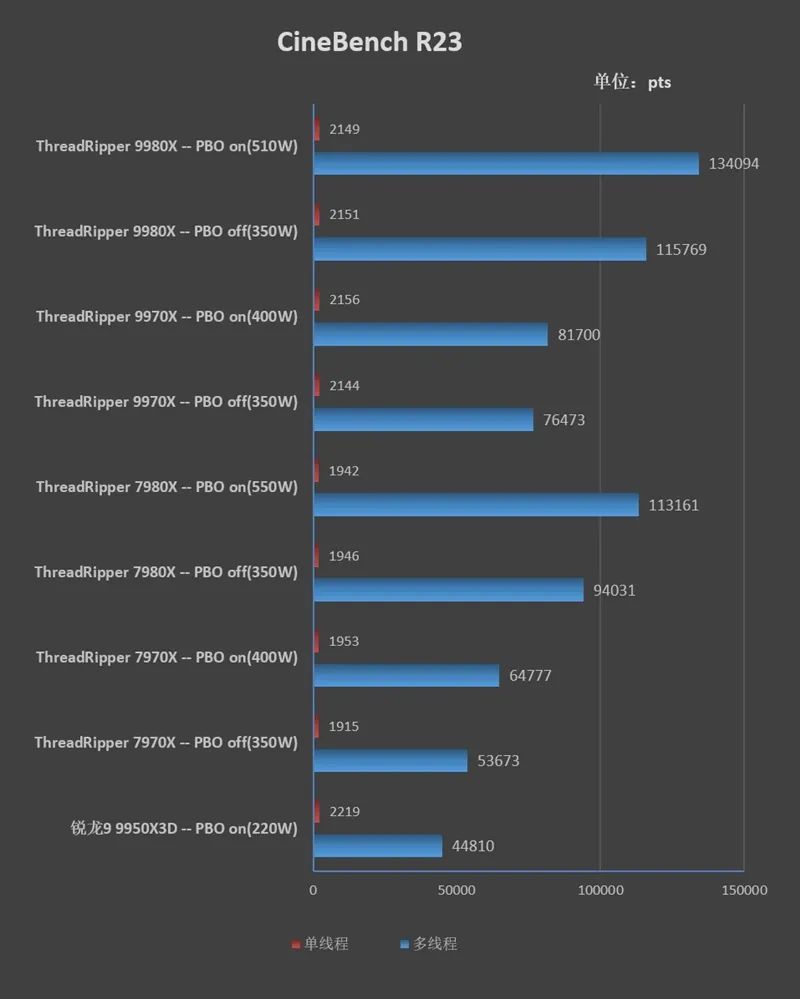
6, CineBench 2024
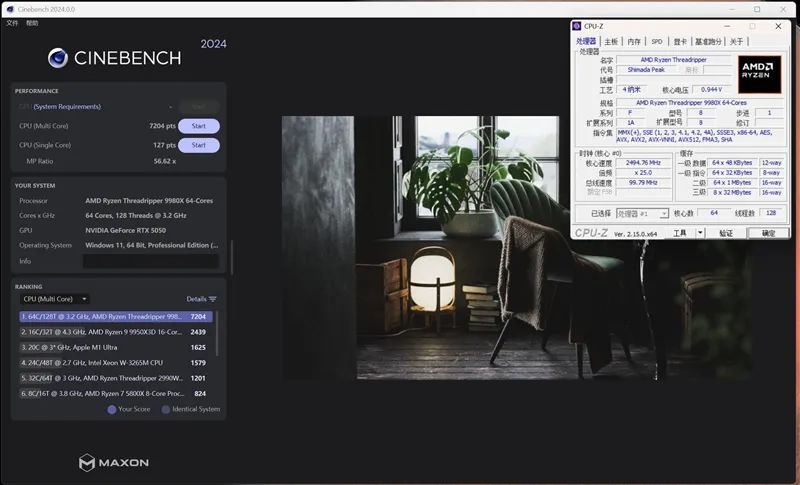
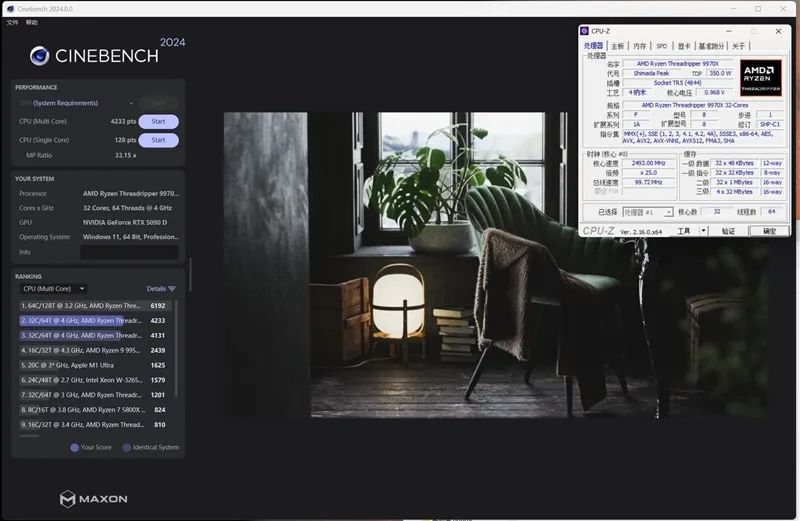
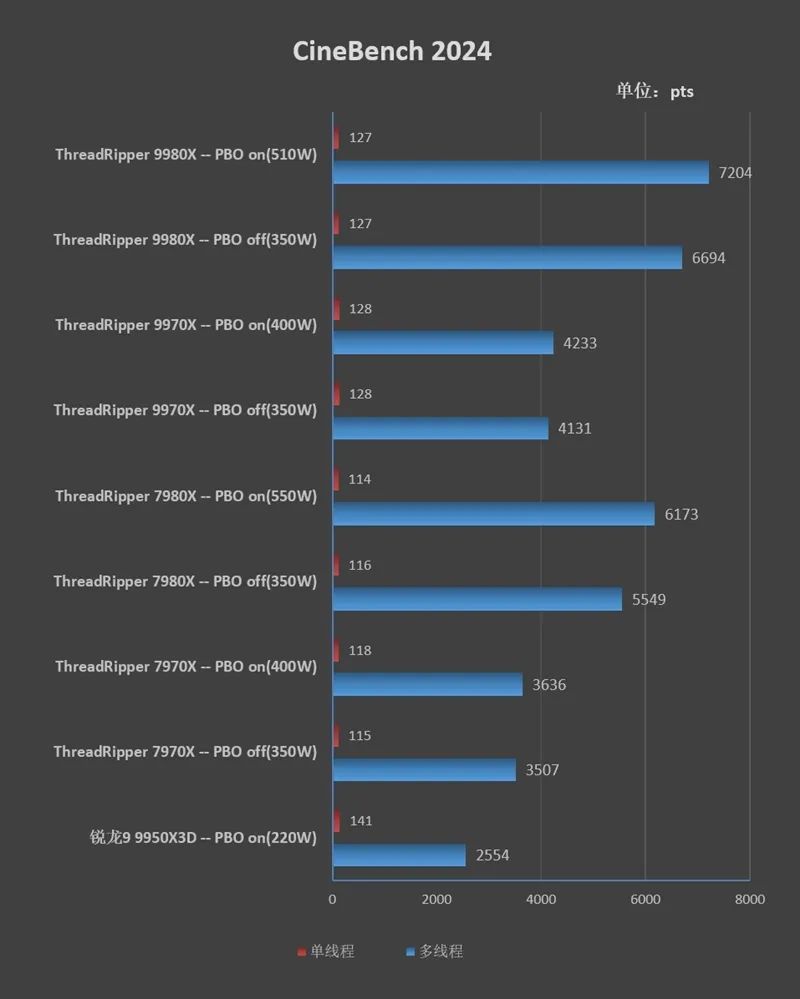
7, 7-Zip
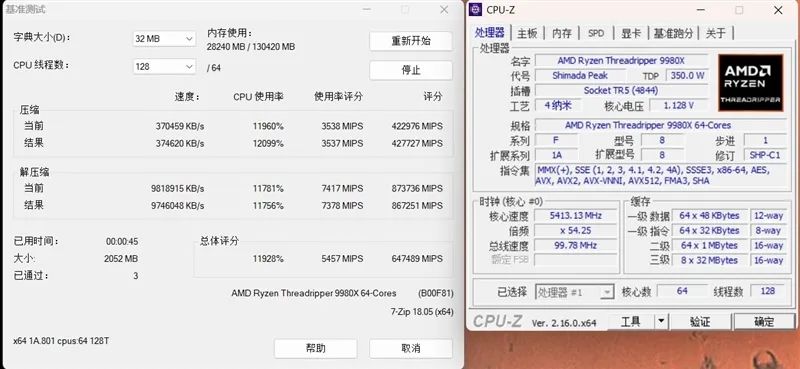
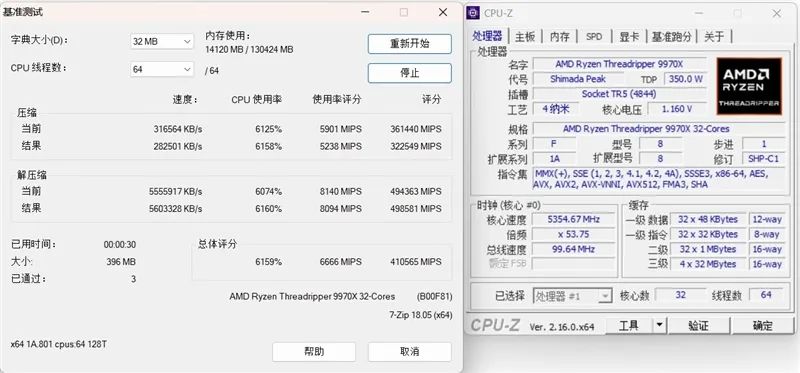
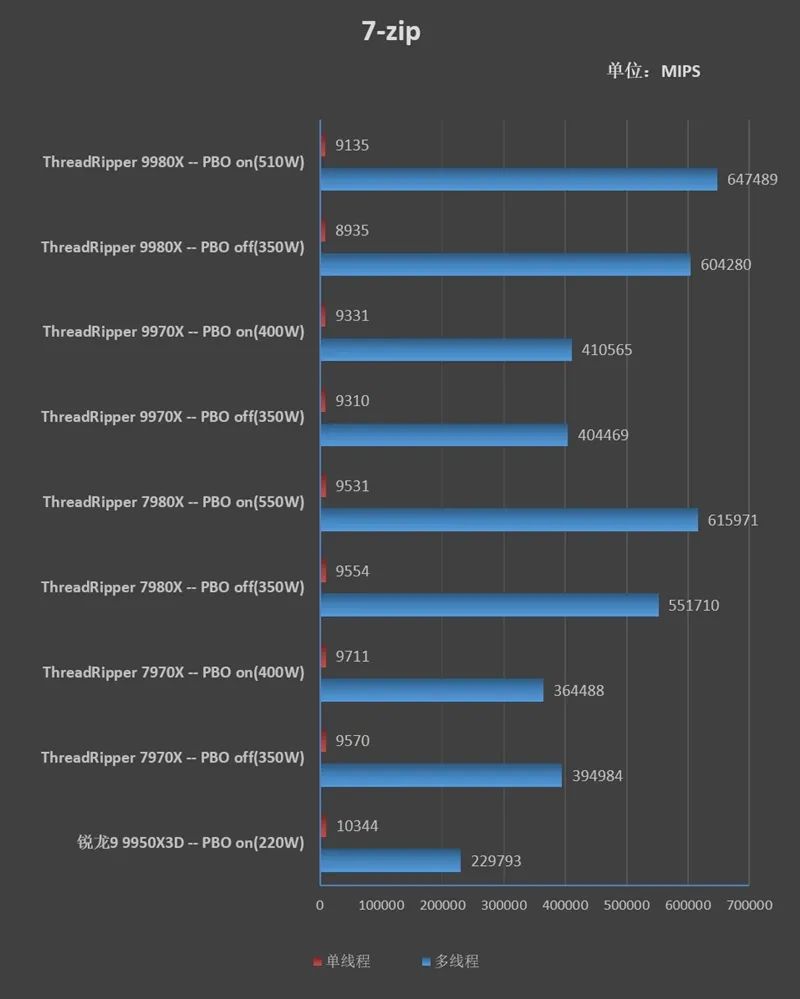
8, PassMark
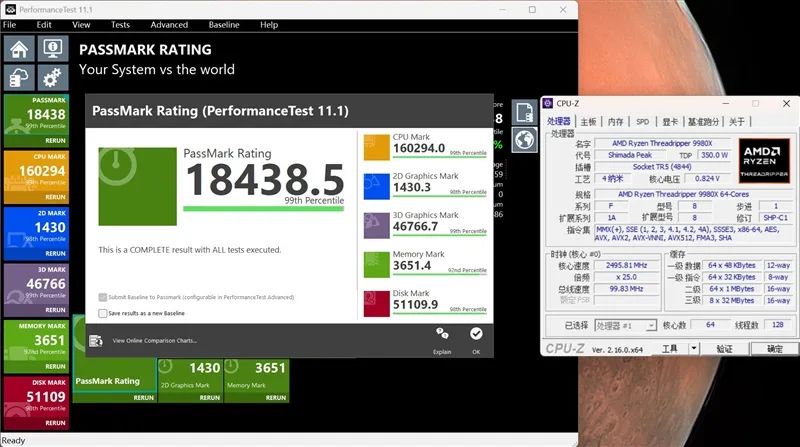
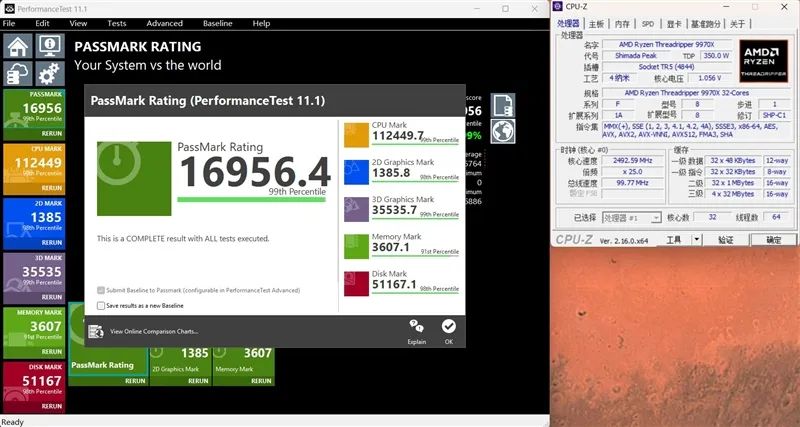
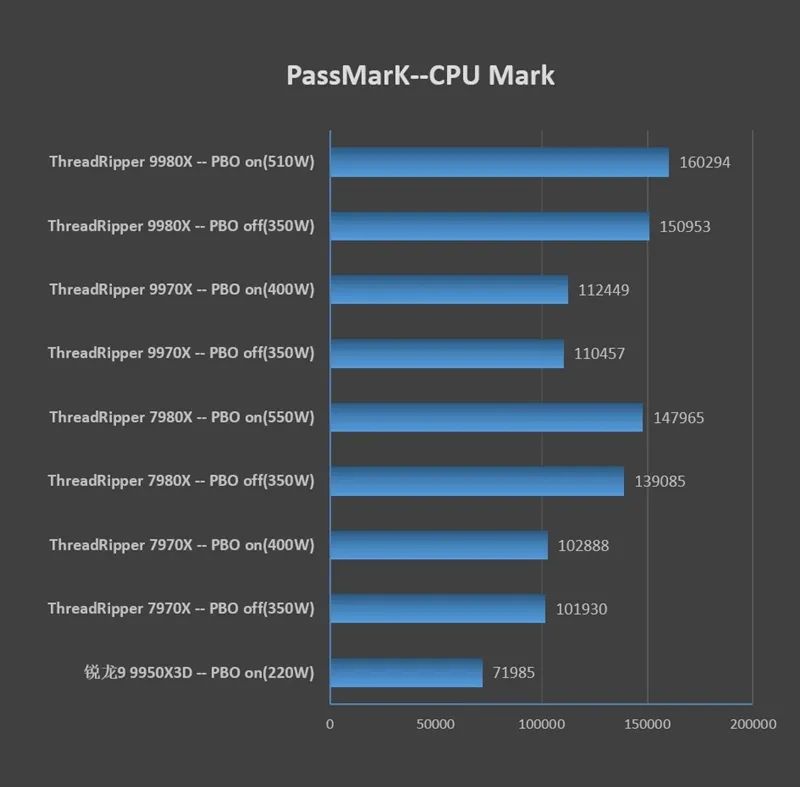
VIII. Productivity Performance Test with PBO Enabled:
1, Blender Benchmark 4.5
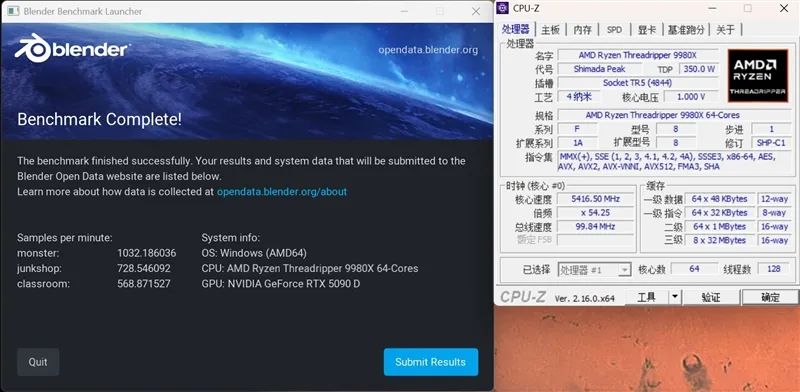
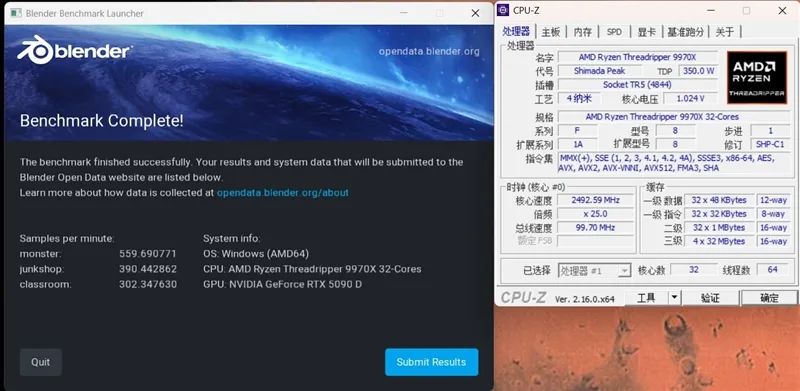
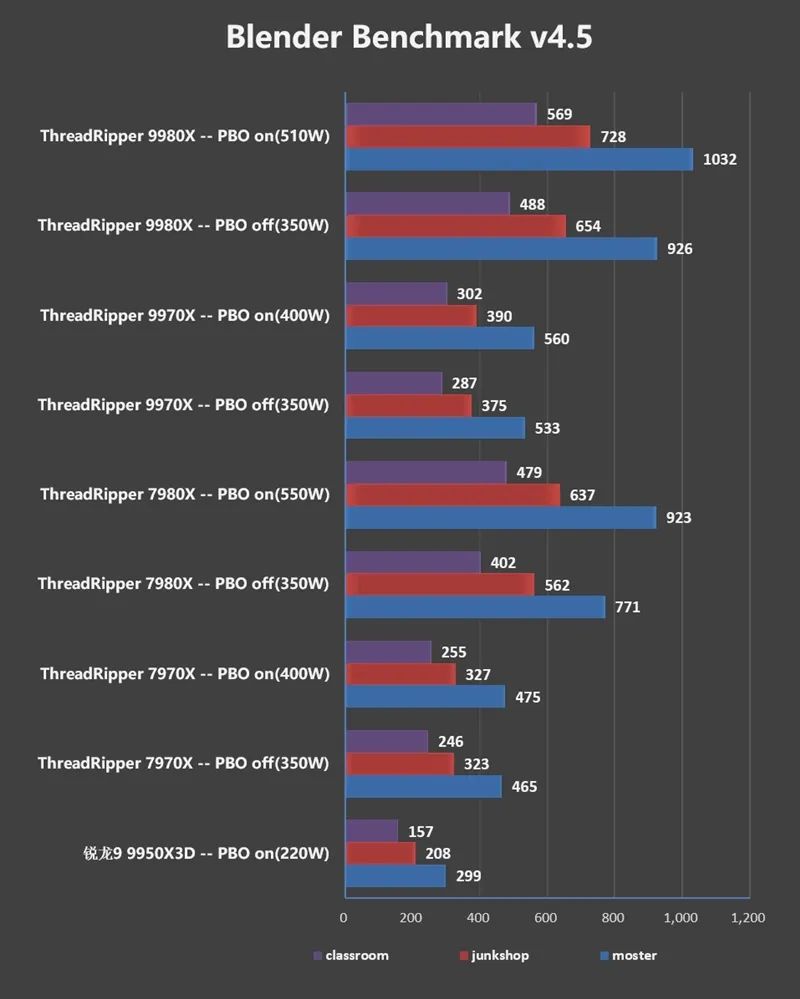
2, Corona 10 benchmark
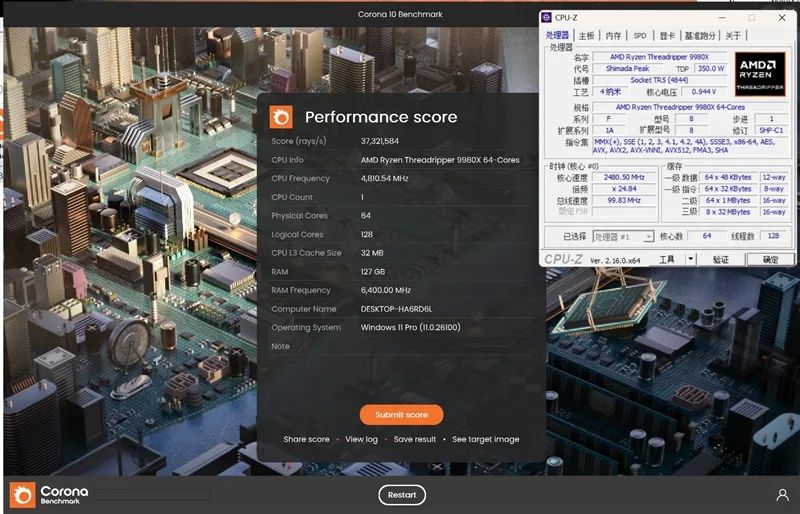
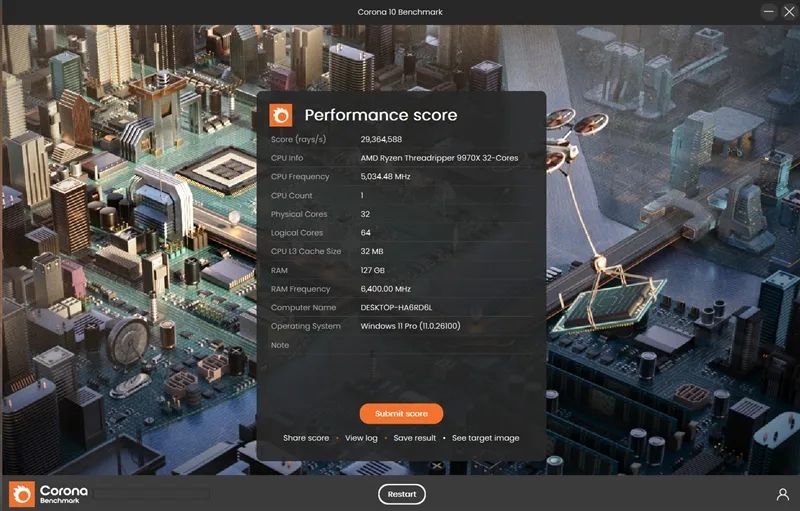
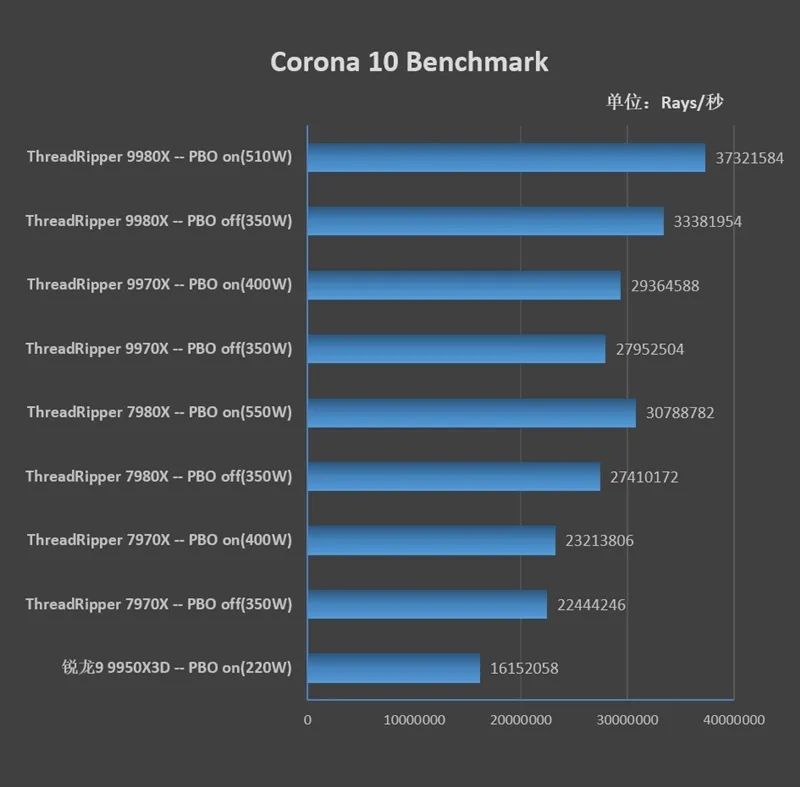
3, handbrake
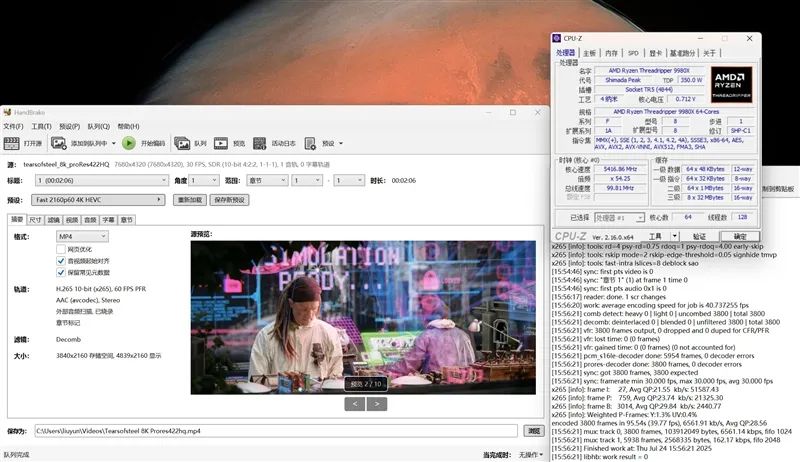
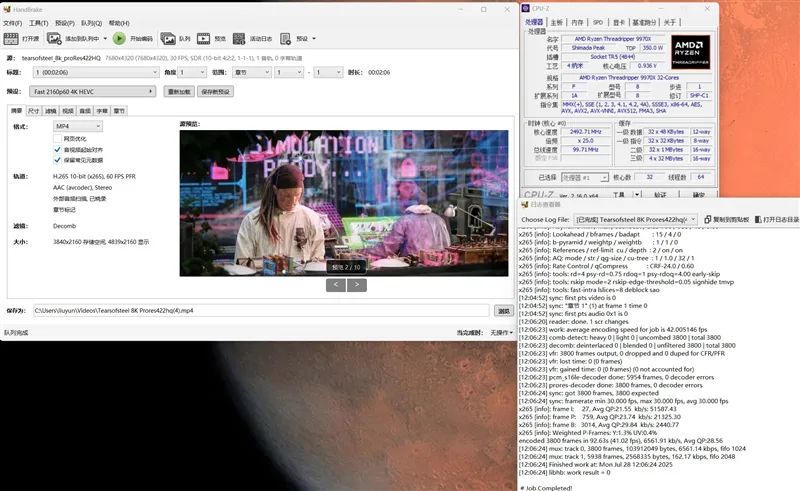
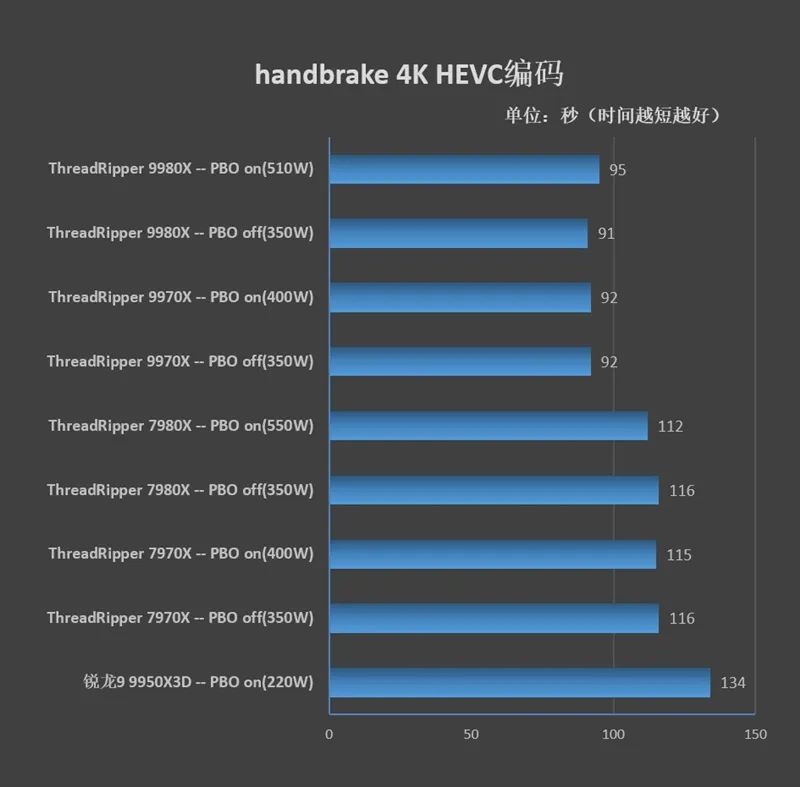
4, V-ray Benchmark 6.0
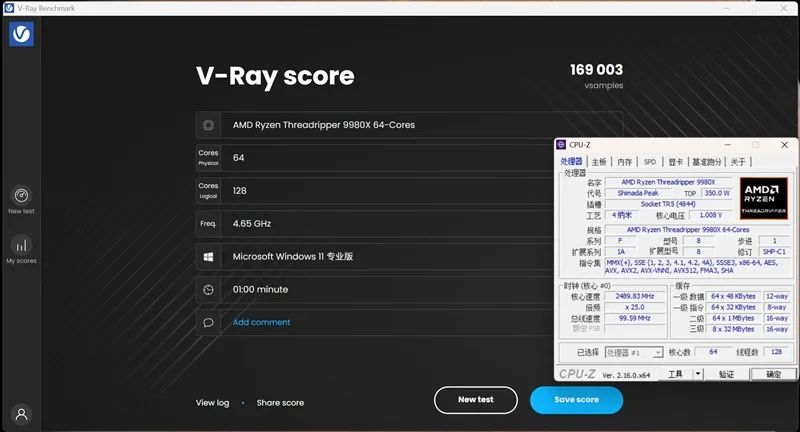
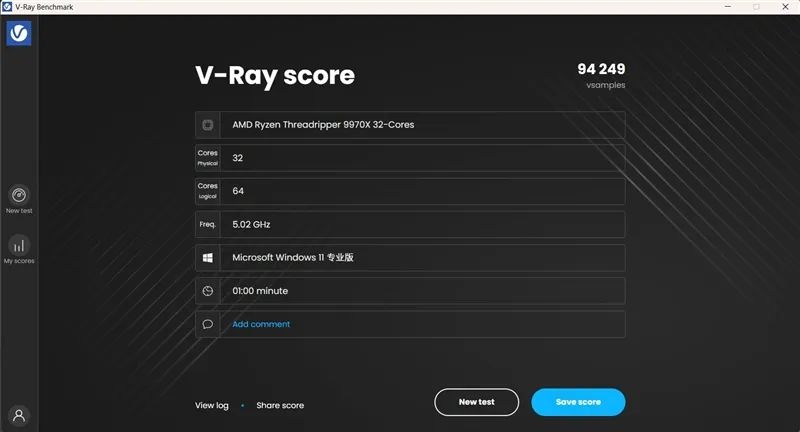
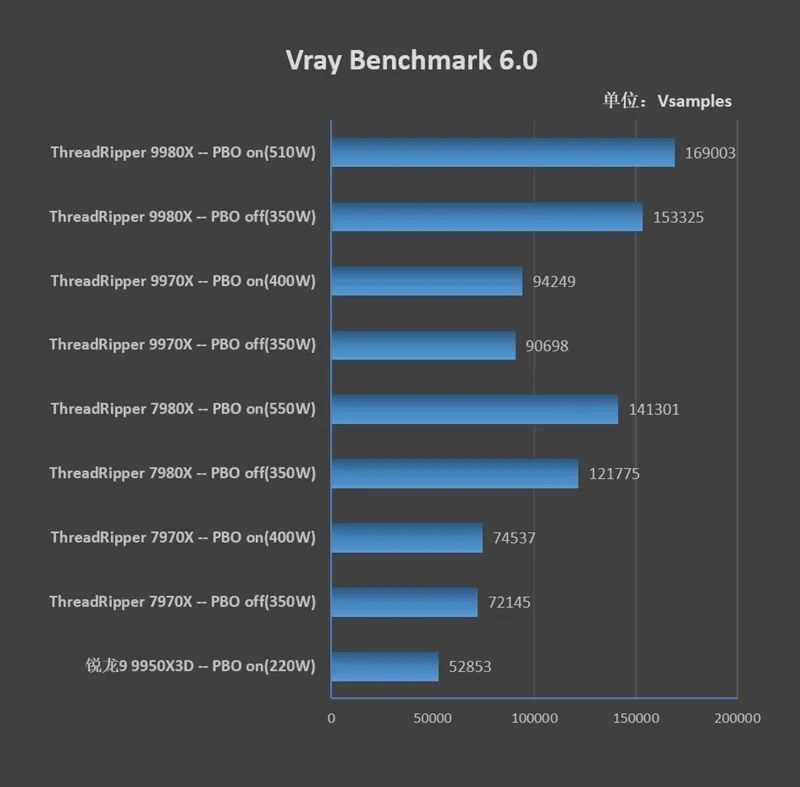
5, Indigo Benchmark
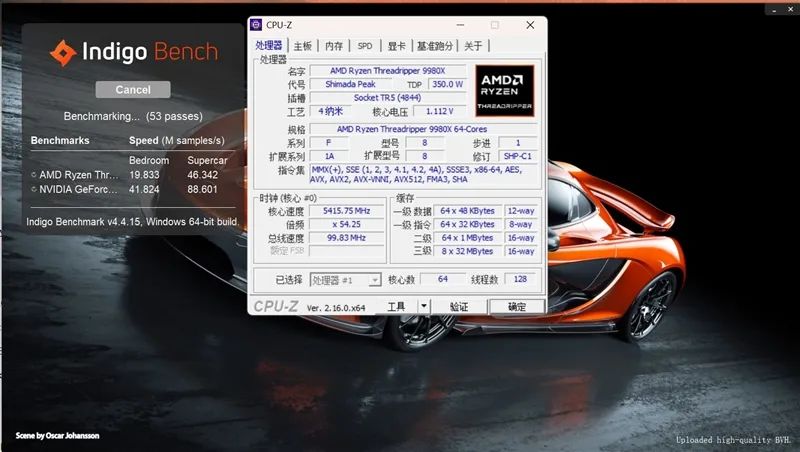
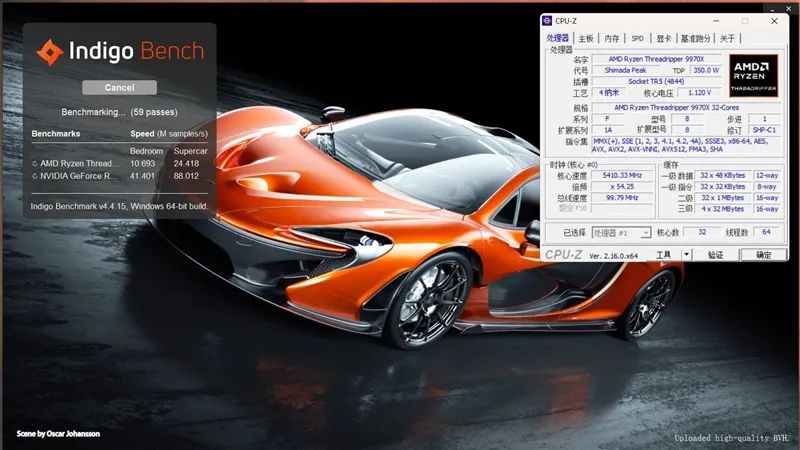
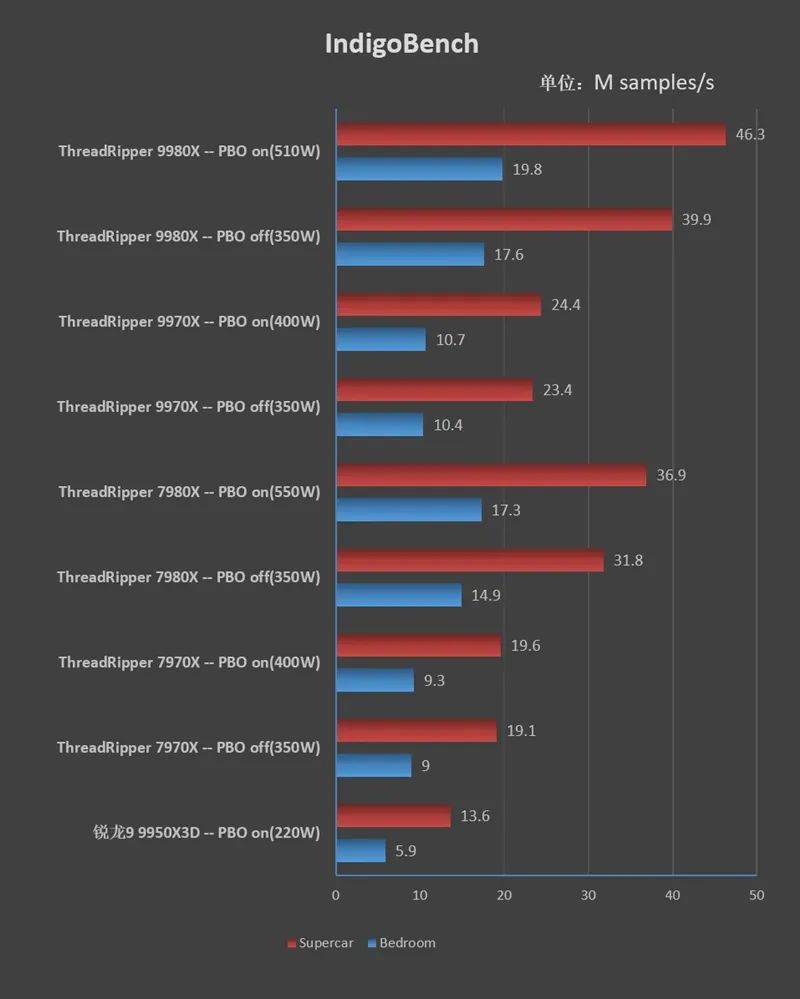
6, Blackmagic RAW Speed Test
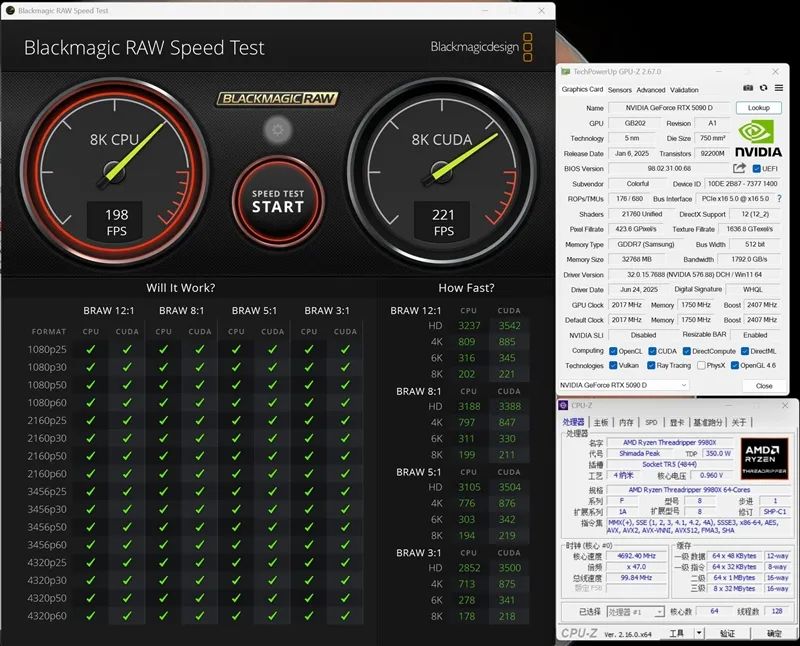
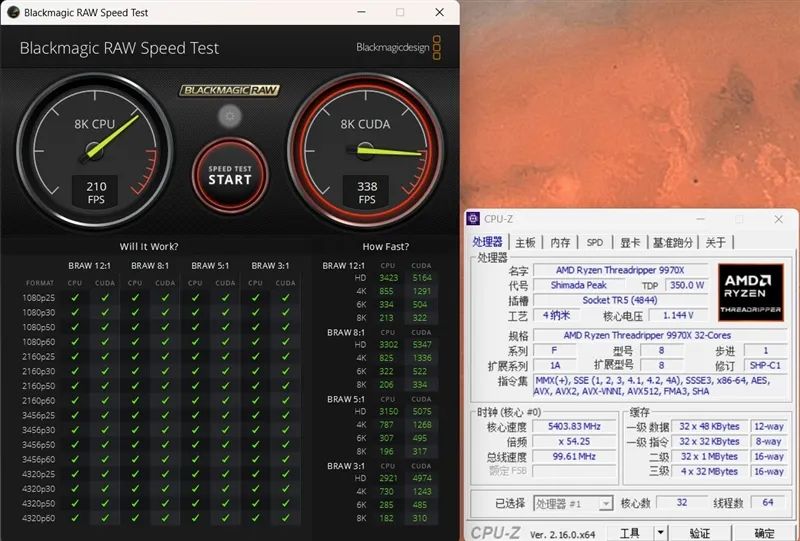
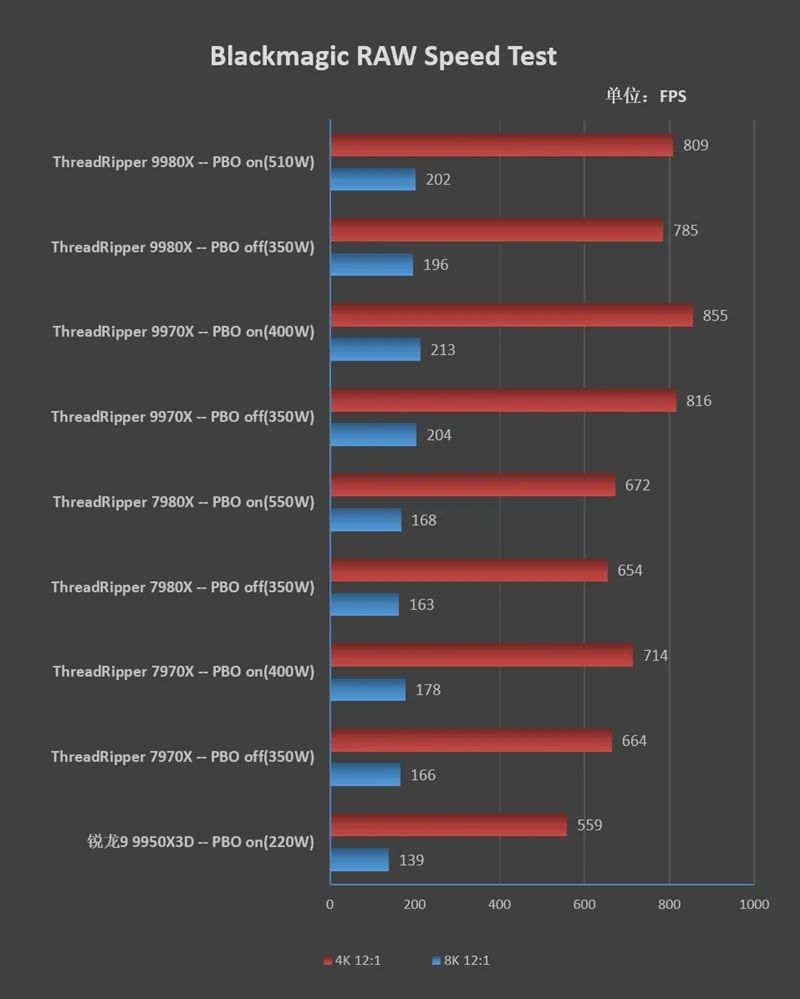
7, POV-Ray
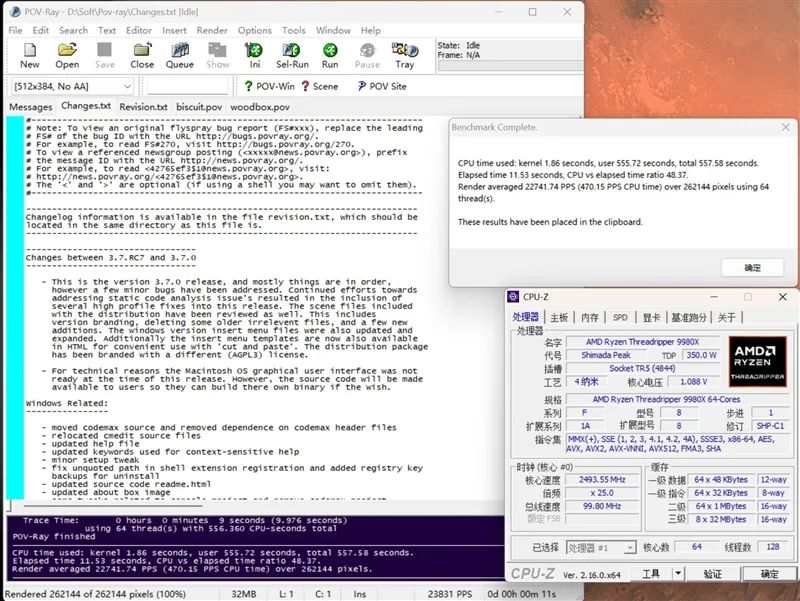
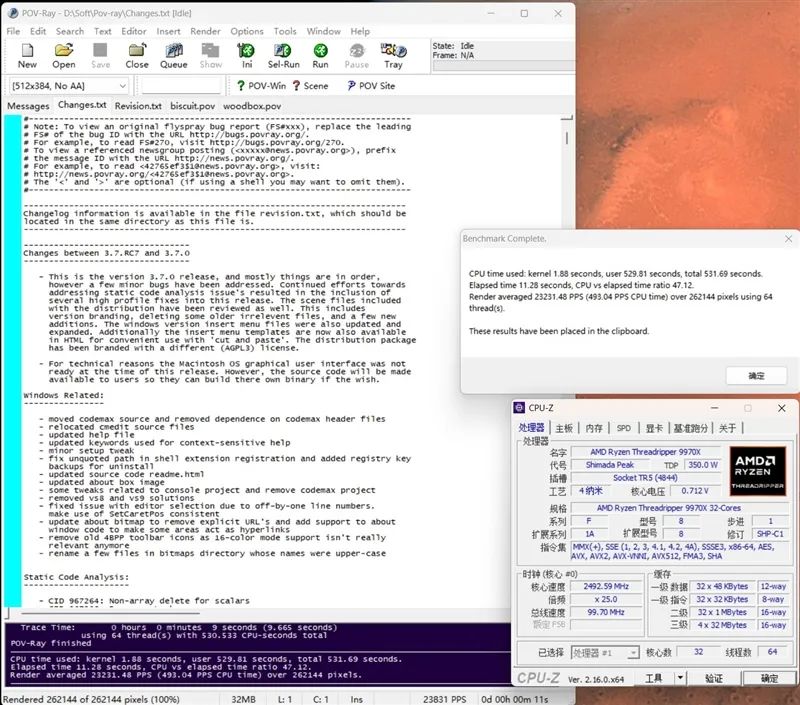
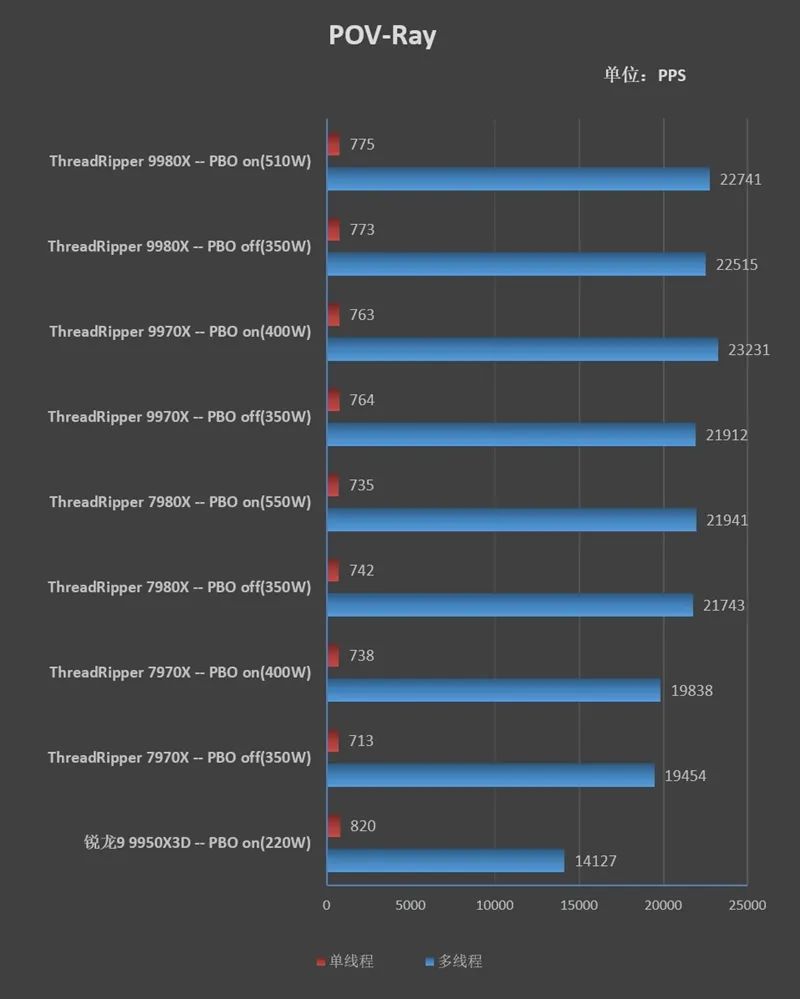
Summary of test data as follows:
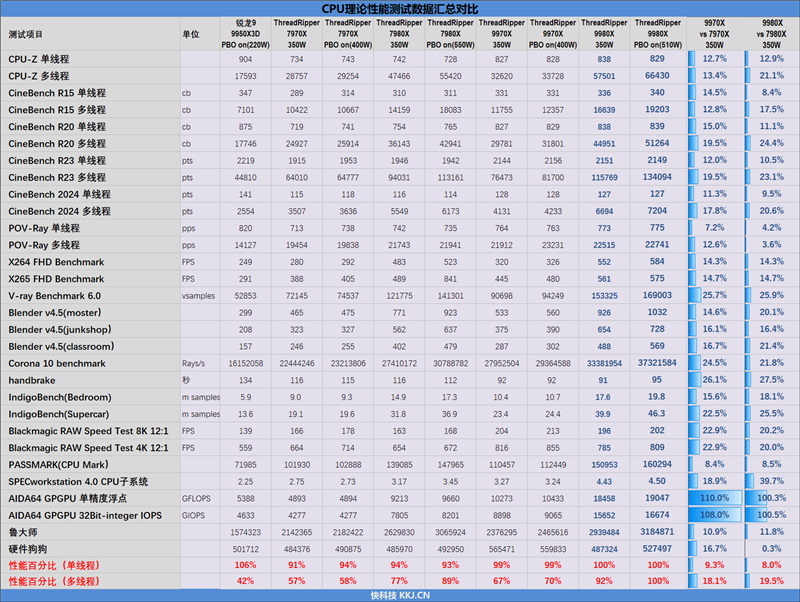
At the default TDP of 350W, the single-core performance of the ThreadRipper 9980X is approximately 8~10% higher than that of the previous-generation ThreadRipper 7980X.
However, oddly, in multi-threaded tests, the ThreadRipper 9980X has a lead of over 20% in most projects, with an average of 19.5%, despite the core count remaining unchanged.
Additionally, even when the ThreadRipper 7980X enables PBO, boosting performance to 550W, its overall performance still falls short of the ThreadRipper 9980X running at 350W.
The ThreadRipper 9970X exhibits similar performance, with a single-core performance lead of around 9% and a multi-core performance advantage of roughly 18% at the default TDP of 350W.
P.s: The scores of AIDA64 GPGPU, 7-zip, LuMaster, and Hardware Dog are for reference only and are not included in performance statistics.
IX. SPECworkstation 4.0.0 Test
SPECworkstation 4.0.0 is a hardware performance testing tool developed by the Standard Performance Evaluation Corporation (SPEC). This testing software can evaluate the productivity performance of hardware such as CPUs and GPUs in different industries, including AI, energy, finance, design, and media.
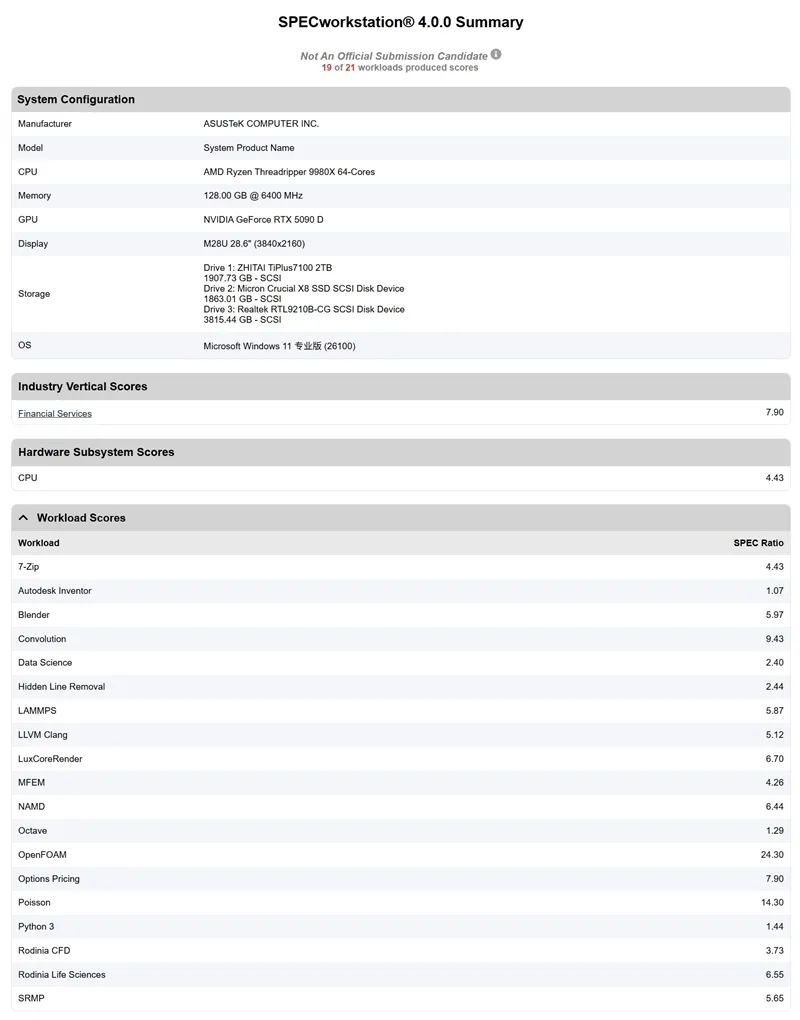
The CPU subsystem score for the ThreadRipper 9970X (at default power consumption) is 4.43.
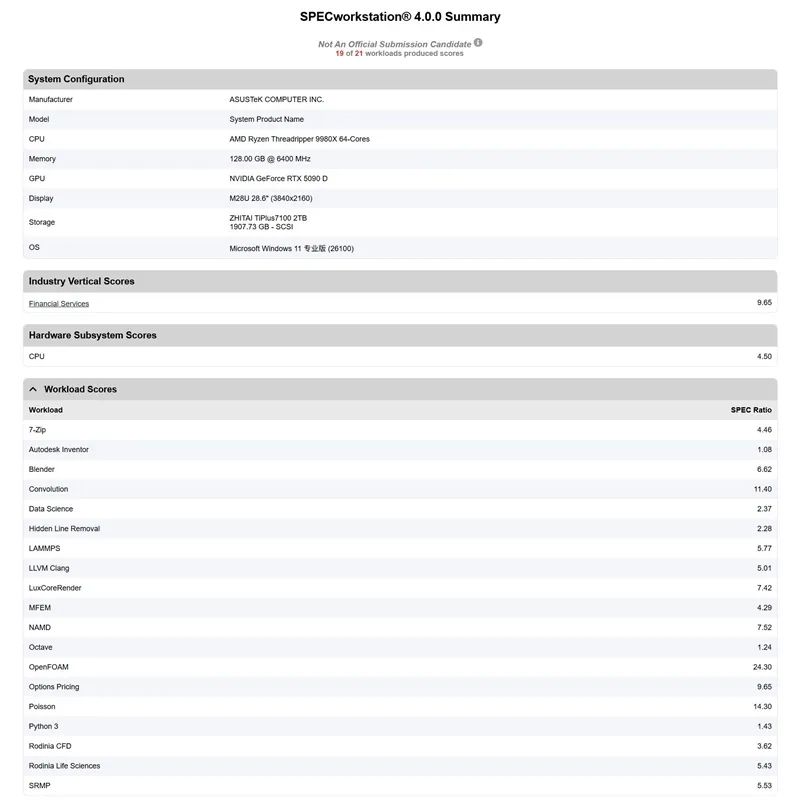
The CPU subsystem score for the ThreadRipper 9980X (at default power consumption) is 4.50.
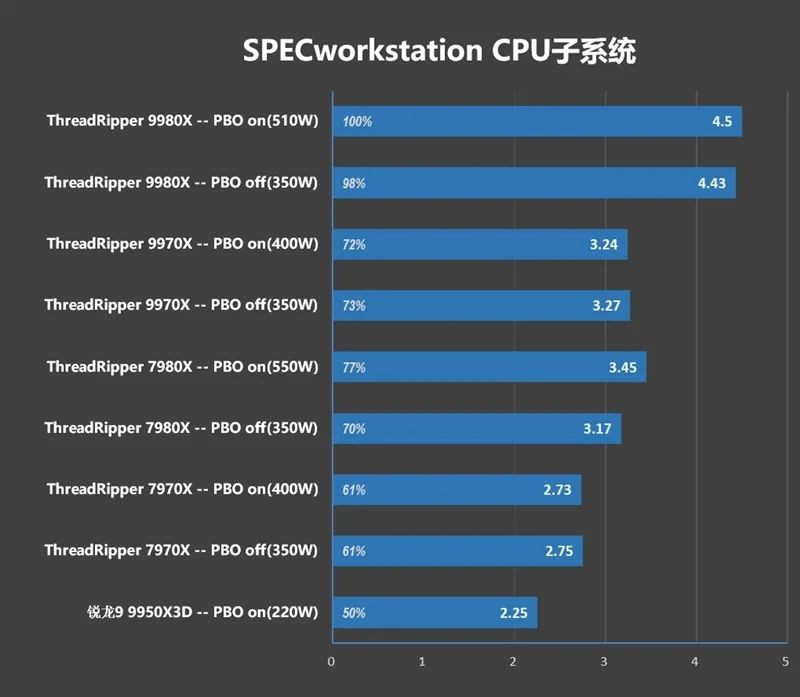
The detailed performance summary of each sub-item is as follows:
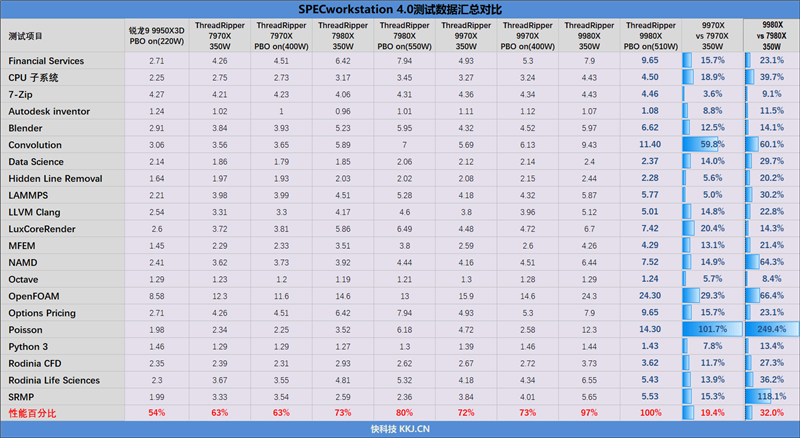
From the SPECworkstation 4.0.0 results, it can be seen that under default settings, the ThreadRipper 9970X is 14% stronger than the previous generation ThreadRipper 7970X, and the ThreadRipper 9980X is 33% faster than the ThreadRipper 7980X.
After enabling PBO, the performance of the ThreadRipper 9980X is improved by about 3%.
X. Lu Da Shi and Ying Jian Gou Gou
Here, we only show the performance of the two processors after enabling PBO.
1. Lu Da Shi Test
Although Lu Da Shi is not a very rigorous testing tool, it is still acceptable to use it to demonstrate the platform's performance.
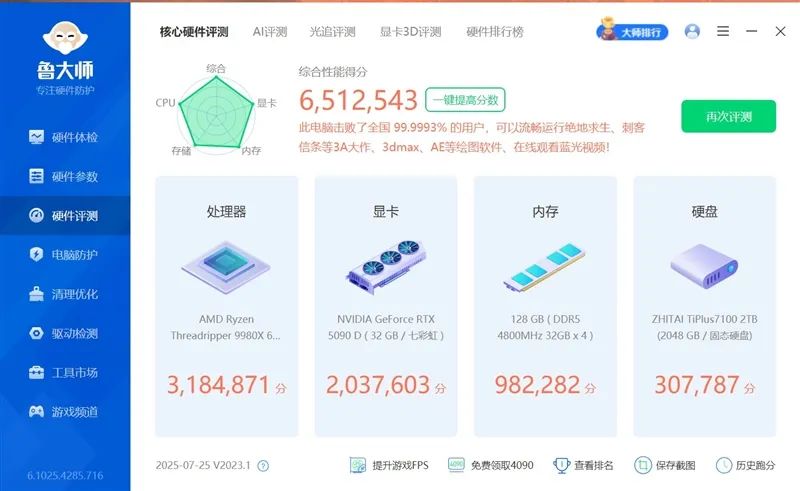
The ThreadRipper 9980X platform scored over 6.51 million points, with the processor scoring up to 3.18 million points. It exceeds 99.9993% of users nationwide.
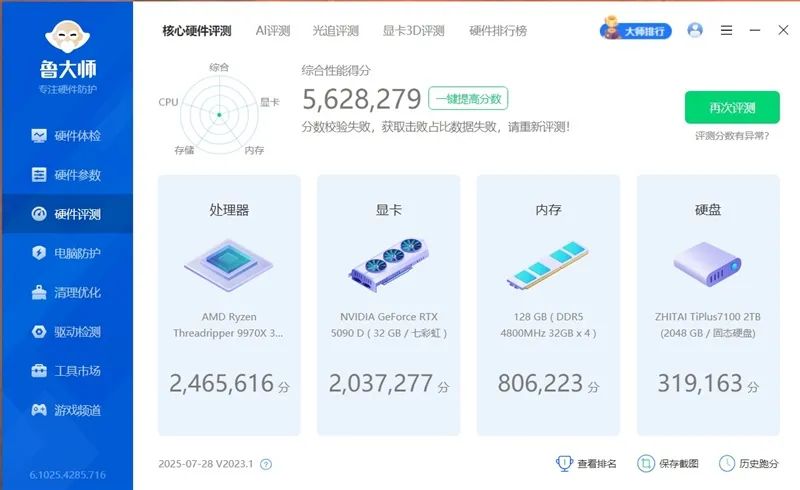
The CPU score of the ThreadRipper 9970X is slightly lower, but it still reaches 2.46 million points.
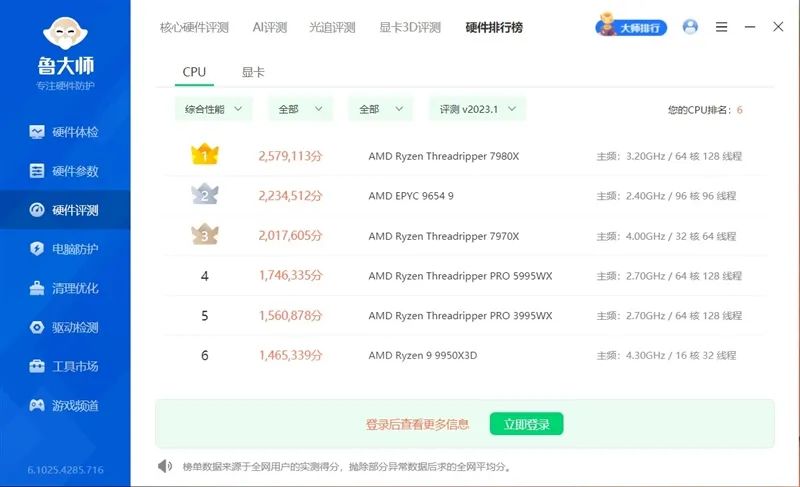
The top score on Lu Da Shi's CPU ranking is still AMD's previous-generation ThreadRipper 7980X, which lags significantly behind the scores of the new-generation processors.
2. Ying Jian Gou Gou Test
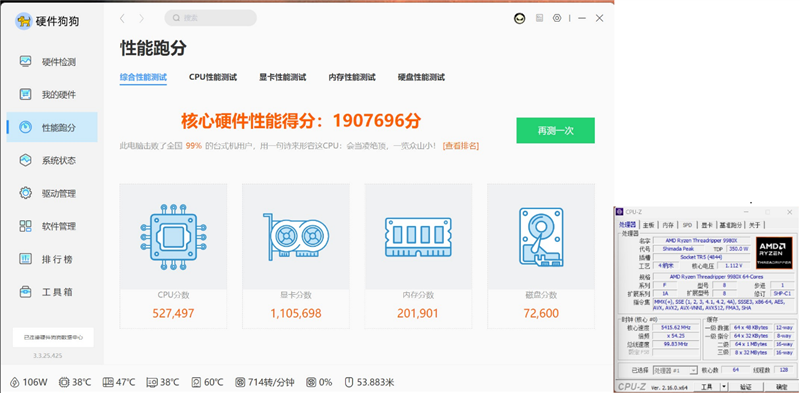
The ThreadRipper 9980X platform scored a total of 1.9 million points on Ying Jian Gou Gou, surpassing 99% of desktop computer users nationwide, with the CPU scoring 527,000 points.
XI. Summary
Since its release in November 2023, the ThreadRipper 7980X has held the throne as the most powerful processor on the HEDT platform until the arrival of the ThreadRipper 9980X today, which finally ends its reign.
However, the ThreadRipper 9980X is far from just a routine upgrade. Its performance in many aspects far exceeds our expectations.
For example, in terms of energy efficiency, the ThreadRipper 9980X does not require any settings in the BIOS. With a default power consumption of 350W, its performance comprehensively surpasses the ThreadRipper 7980X, which has a performance release of 550W after enabling PBO.
When the power consumption is only 350W, thanks to the huge heat dissipation area of the processor, only a 360W water cooler is needed to control the full load temperature below 70°C. At the same time, due to the extremely low temperature, the noise of the radiator can be almost ignored.
Therefore, a conclusion can be drawn that, with the support of the new-generation Zen 5 architecture and TSMC's 4nm process technology, the ThreadRipper 9980X can outperform the ThreadRipper 7980X by 20% under the same power consumption; under the same or slightly stronger performance, the power consumption of the ThreadRipper 9980X can be reduced by 40%.
Now, even if you are a DIY novice, you can experience unprecedented powerful performance while keeping the platform at a low temperature and low noise.
Despite such significant upgrades, AMD has set the launch price of the ThreadRipper 9980X at 40,980 yuan, which is more than 5,000 yuan cheaper than the ThreadRipper 7980X.
The same applies to the ThreadRipper 9970X. With 20% better performance than the ThreadRipper 7970X, its launch price is only 20,970 yuan, which is 19% cheaper than the 25,999 yuan ThreadRipper 7970X.
Of course, the surprises of the ThreadRipper 9980X go far beyond that. In video creation, we tested using the Blackmagic RAW Speed Test and found that the encoding performance of the ThreadRipper 9980X is comparable to that of the RTX 5090.
It should be noted that this tool currently only supports 48 threads. If encoding is performed simultaneously in triple mode, the ThreadRipper 9980X will bring nearly four times the performance of the RTX 5090.
With 128 cores, the possibilities are endless!
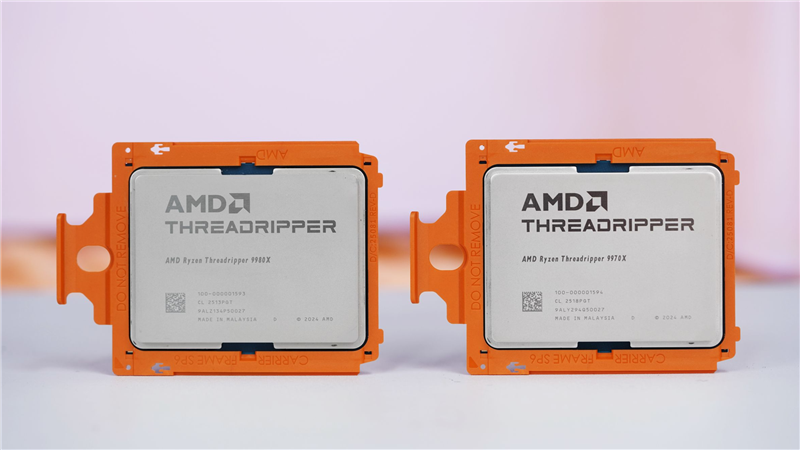
The summary of the tests on the ThreadRipper 9980X/9970X processors is as follows:
1. All-Core Frequency
When all cores are fully loaded, the all-core frequency of the ThreadRipper 9980X is 4.7GHz, which is 100MHz lower than the ThreadRipper 7980X.
The ThreadRipper 9970X can achieve an ultra-high all-core frequency of 5.3GHz, which is 500MHz higher than the ThreadRipper 7970X.
In addition, under the same power consumption, the operating frequency of the ThreadRipper 9980X will be about 100MHz higher than that of the ThreadRipper 7980X.
2. Power Supply
For the ThreadRipper 9970X, an 850W gold-rated power supply is sufficient.
As for the ThreadRipper 9980X, after enabling PBO to unlock power consumption, using an 850W power supply will result in frequent restarts. It is recommended to purchase a 1300W single-rail platinum power supply.
After all, if you've already spent 40,000 yuan on the processor, spending an extra thousand yuan on a platinum power supply for stable operation is acceptable.
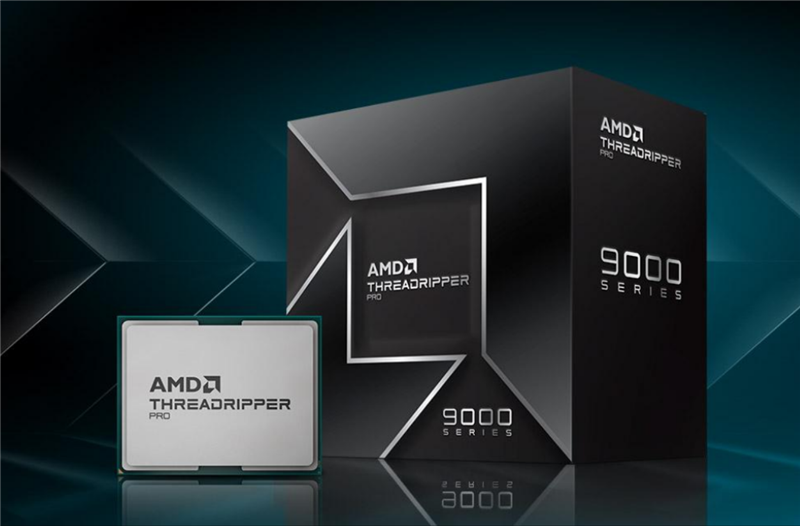
Of course, the ThreadRipper 9000 series still has huge potential to be tapped!
For example, the single-precision floating-point performance of the ThreadRipper 9980X reaches 19 TFLOPS, and the single-precision integer performance also reaches 16 TIOPS, both achieving twice the performance of the previous generation. After in-depth optimization for future applications, the creation efficiency can be greatly improved. For content creators where time is of the essence, nothing is more important than efficiency!
AMD Ryzen Threadripper 9000 new products will be available for sale on the JD.com platform at 9 PM on July 31.




